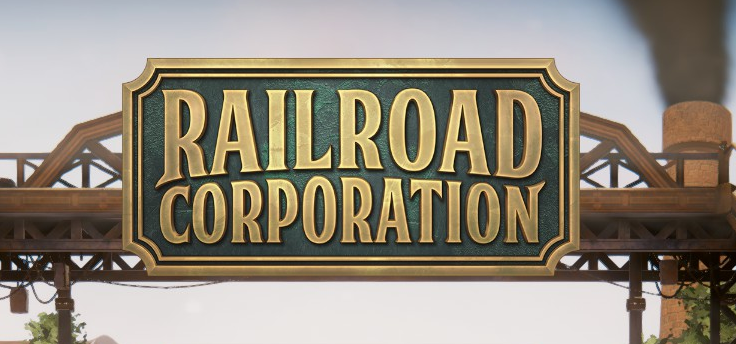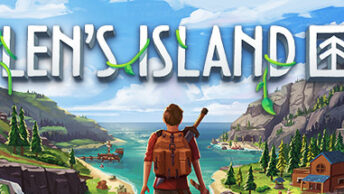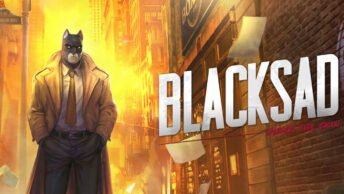The fully functioning game has been delayed. Please pardon the inconvenience.
Type: Single-player, Multi-player
Genre: Management, Simulation
Strategy
Developer: Corbie Games
Publisher: Iceberg Interactive
Release date: 18 November, 2019

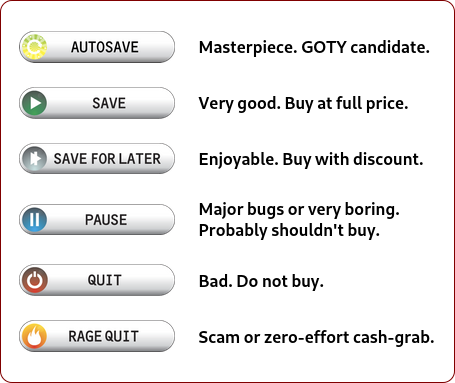
Intro
It’s no secret that success spawns imitators in the gaming industry. This isn’t a bad thing – follow-up games offering iterative improvements upon a solid basic idea is what turns games like DOOM into the FPS genre. People naturally clamor for spiritual successors to their most beloved games, even when the original studio’s doors have been shut. In that sense, a few games tend to loom large over a whole subgenre of games, the way that most 4X games can’t see to escape Sid Meyer’s Civilization’s orbit. Whereas I was surprised to get something completely different in Train Valley, Railroad Corporation is definitely claiming Railroad Tycoon as its direct lineage.
Here, we have (yet another) train company management game that tries to recapture Railroad Tycoon or Transport Tycoon Deluxe’s style of business management and modernize it to having full 3d graphics, a gridless 3d world, and offering other new gameplay innovations, the most noteworthy of which are a tech tree and the ability to hire workers.
So how well does it do? Well, on the one hand, I still want to play this game, at least to beat some more of the campaign missions. On the other, however, this game makes me want to play Open Transport Tycoon Deluxe again. I think I prefer the 2d interface, the grid and tiles that make what you are doing clear and precise, and most of all, those blessed, blessed traffic signals.
All Aboard!
OK, so probably most of your who have the slightest interest in this genre know at least something about Tycoon games (although Rollercoaster Tycoon probably did more to popularize the “tycoon” label than Railroad Tycoon), but here’s a quick rundown of the basics for those who are such fans of Save or Quit reviews you read them even about games you’re not interested in:
You play as the manager of a railroad company. (This game in particular is set starting in the early 19th century, just as locomotives were first being invented in the pre-Civil War United States.) When you start a mission or sandbox map, there is a lot of wide open terrain dotted by a handful of hamlets, towns, and cities that all consume different kinds of goods and/or produce different kinds of goods.
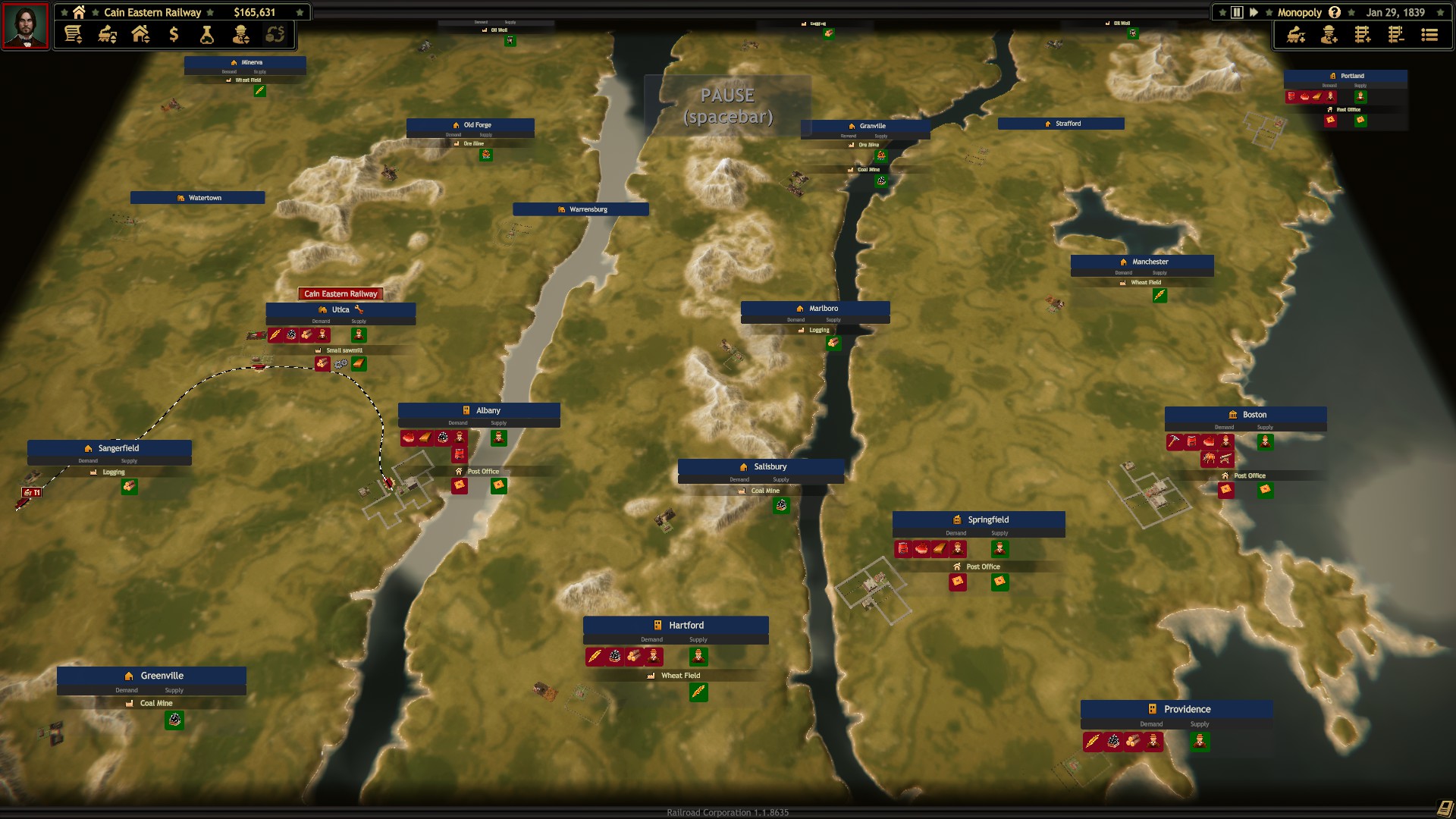
You build railways to connect these towns and buy low, sell high, get rich, the whole mercantile spiel. Missions have set goals to complete, like delivering 10 cars of a certain finished product to a specific city to win, while sandboxes go on until you either lose or get bored. You lose if you go beyond a set amount into debt.
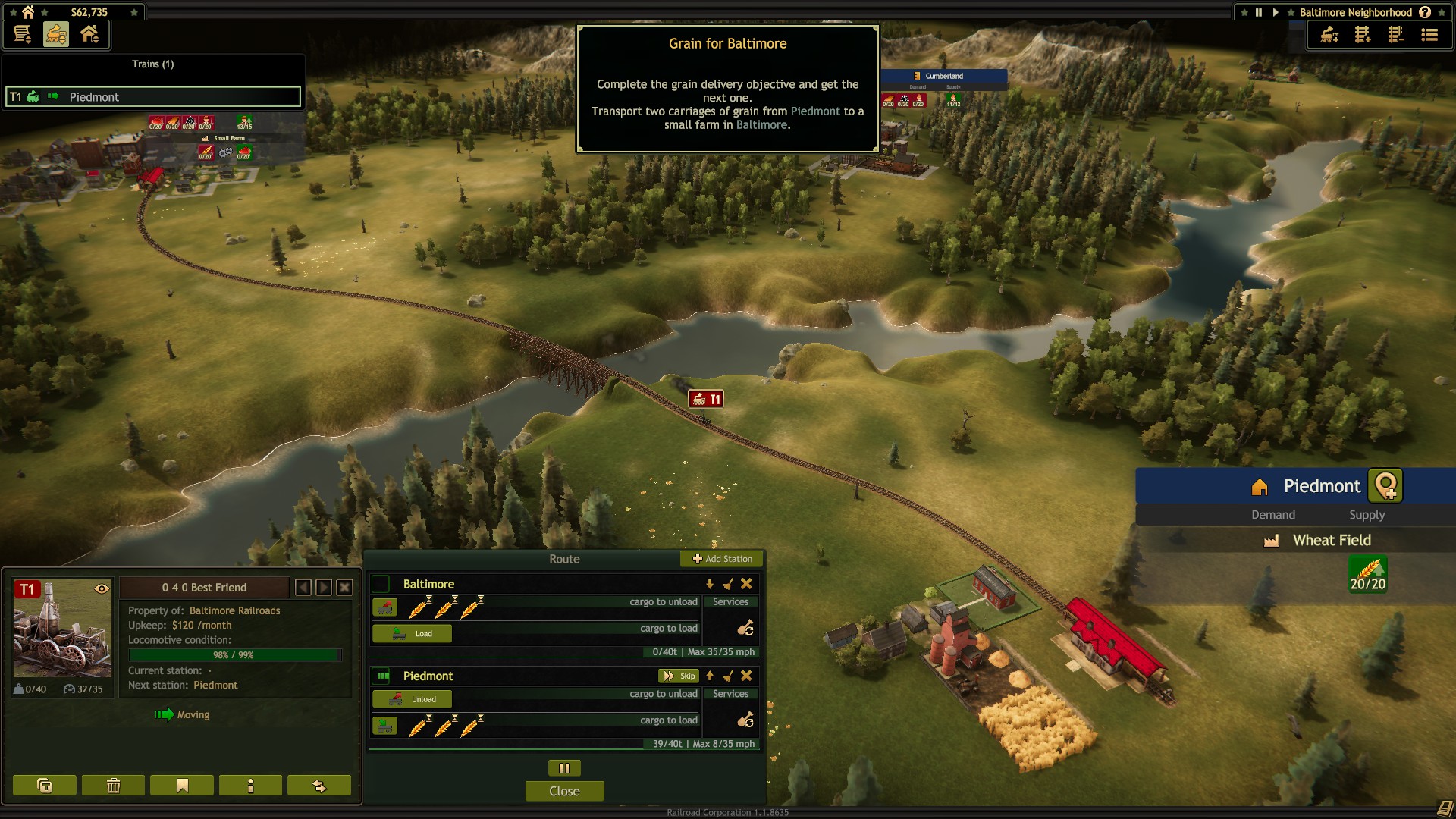
Doing this requires you first buy one of 11 types of classic trains that the game has modeled. You eventually get to the huge cylindrical beasts as you progress through the campaign, but you start the game only able to purchase the Best Friend, a train so dorky looking it’s honestly a little cute…
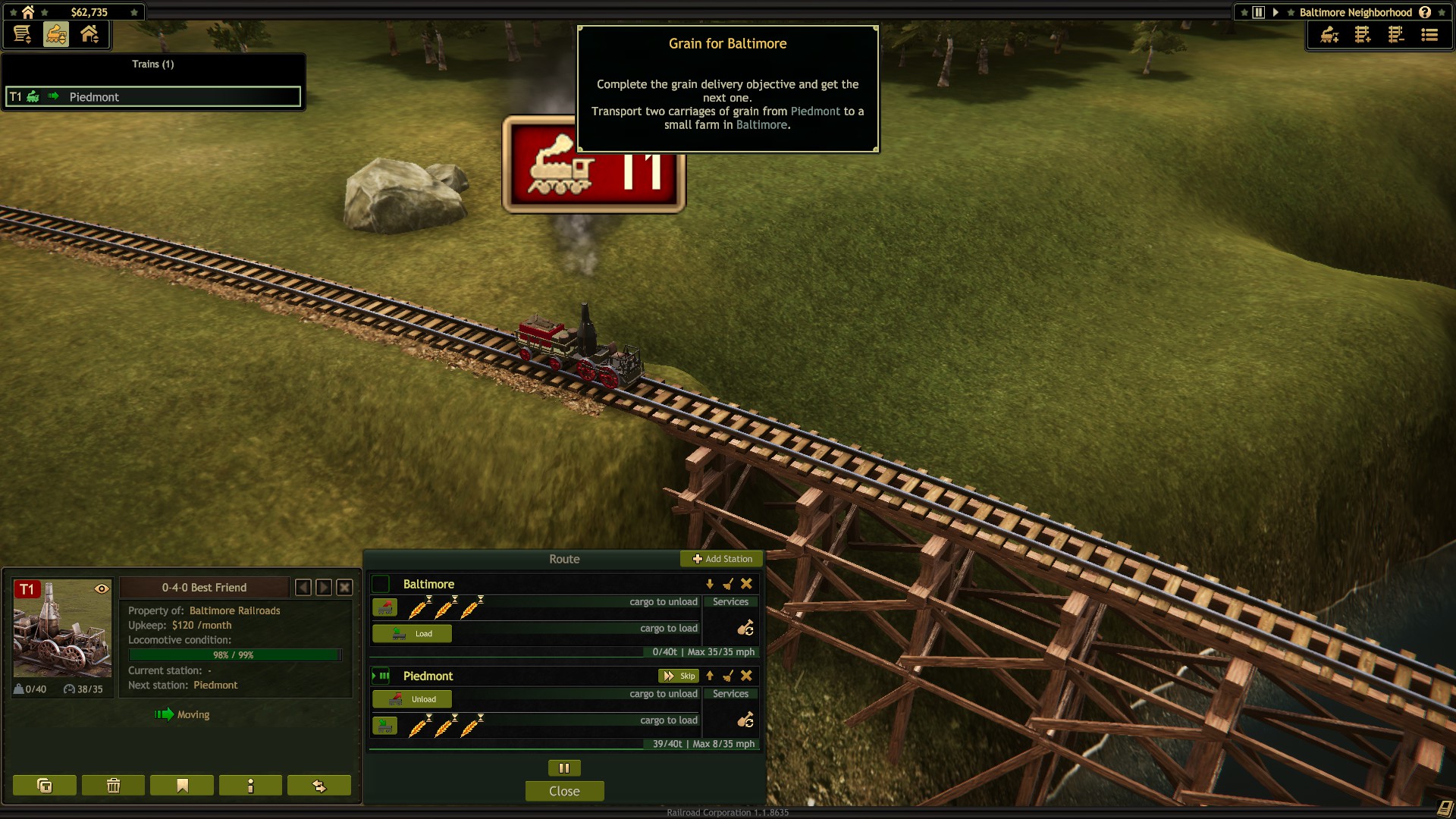
Each train has its own statistics and its own upgrade tree. In Railroad Corporation, unlike Railroad Tycoon and most of its followers, you need to actually research new trains yourself, instead of having historic trains become available when they historically hit the market. Even though you need to research trains and make improved models of them, you still have to buy them off the market after you’ve invented them. Did we invent them or not? If we aren’t inventing these models of trains, what are the scientists doing? Do I need a full team of scientists and a year’s time to figure out how to turn the ignition key on a store-bought model or something?
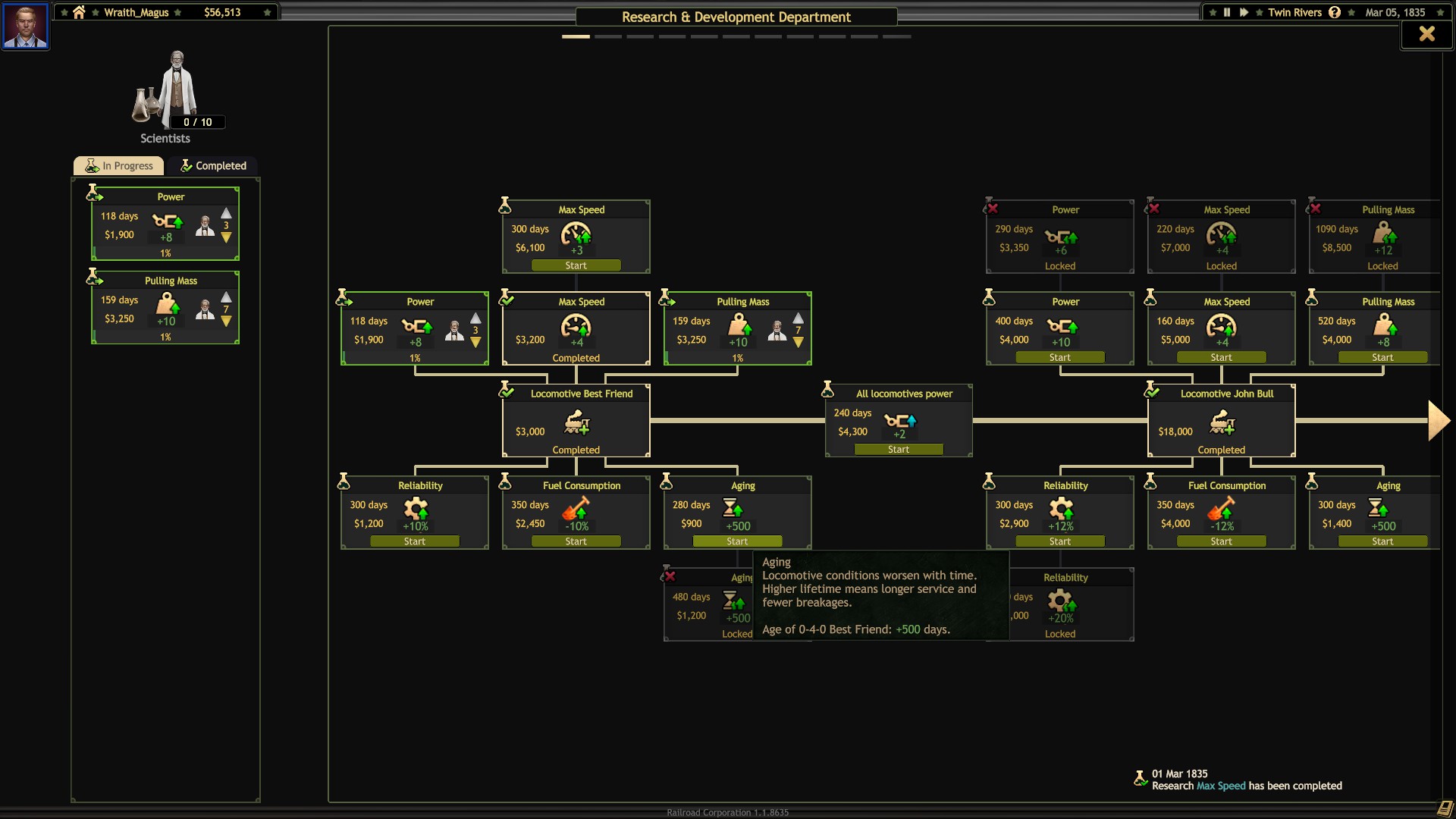
In campaign mode, your tech research is kept from one mission to the next, but only one train and its specific upgrades are added to the tree per mission. Also, only completed research is carried over – partial research is lost. In sandbox mode, the full tree is available from the start but you have no ability to carry over upgrades.
You have 10 scientists in the basic laboratory and the tier 3 laboratory has 20 scientists. Each scientist produces logarithmically less research when on a team, so three scientists on one project are only twice as fast as one scientist on their own, and it takes seven scientists to get up to four times as fast as a lone scientist. This encourages paying for lots of research at once later in a mission when you can afford the costs to start research, but you’re too limited in how much money you can devote to anything but laying down new rail lines or buying products you can sell early in a mission to spend money on more than one of the cheapest research projects available. (And that’s when you even bother to buy the laboratory at all.)
Also unlike most other train tycoon games, no train ever goes obsolete. As dorky and ancient as that Best Friend model is, if you choose one of the companies, you always start with your Best Friend by your side. It’s also not entirely a bad train compared to trains that should render it utterly obsolete, since it tends to cost an eighth as much as later models and you don’t have problems with it being unable to climb a hill with any kind of load the way that early trains are so obviously inadequate in most other games. This ironically means that there’s no reason to ever research upgrades on certain trains or use them at all. Cherry-pick only the most efficient ones, and leave the ones like John Bull that have 50% more carry capacity but go slower and cost twice as much in the dustbin of history. Since you unlock only one train’s portion of the tech tree per mission, you tend to wind up having fully researched the trains you like while totally ignoring research for missions that don’t give you decent trains except to perform the mandatory research for the next tier of train to unlock in the next mission.
After you have a train, you need to build the rails they run upon. Because this is on a gridless 3d surface, this is done with rails that are drawn like a “curve” tool in paint programs that you place down in segments.
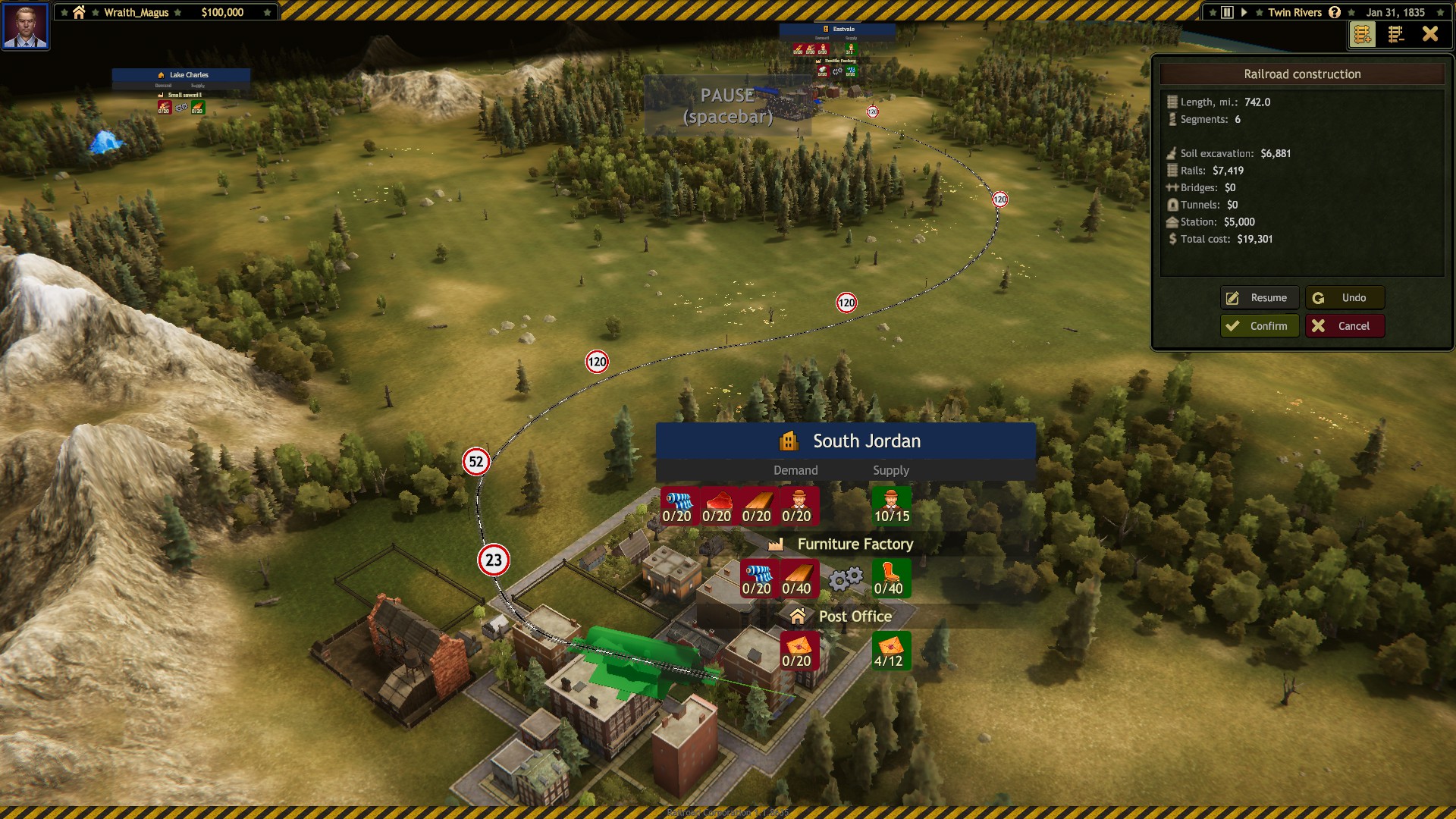
I should point this out because the game doesn’t have any instructions telling you about this anywhere – those signs are the maximum speed for a given track, due to the degree of curve. More severe curves or having track that has to go up or down any significant amount of elevation without having lots of space between points you click drastically reduce the speed of trains crossing them. In the track above, the slow gentle curves have a full 120 mph speed limit, but the sharper curves as I bend the track to approach the town around the side reduce the maximum speed the train can take. Also, all trains seem to have the same speed limits, even when they couldn’t make anything close to 120 mph.
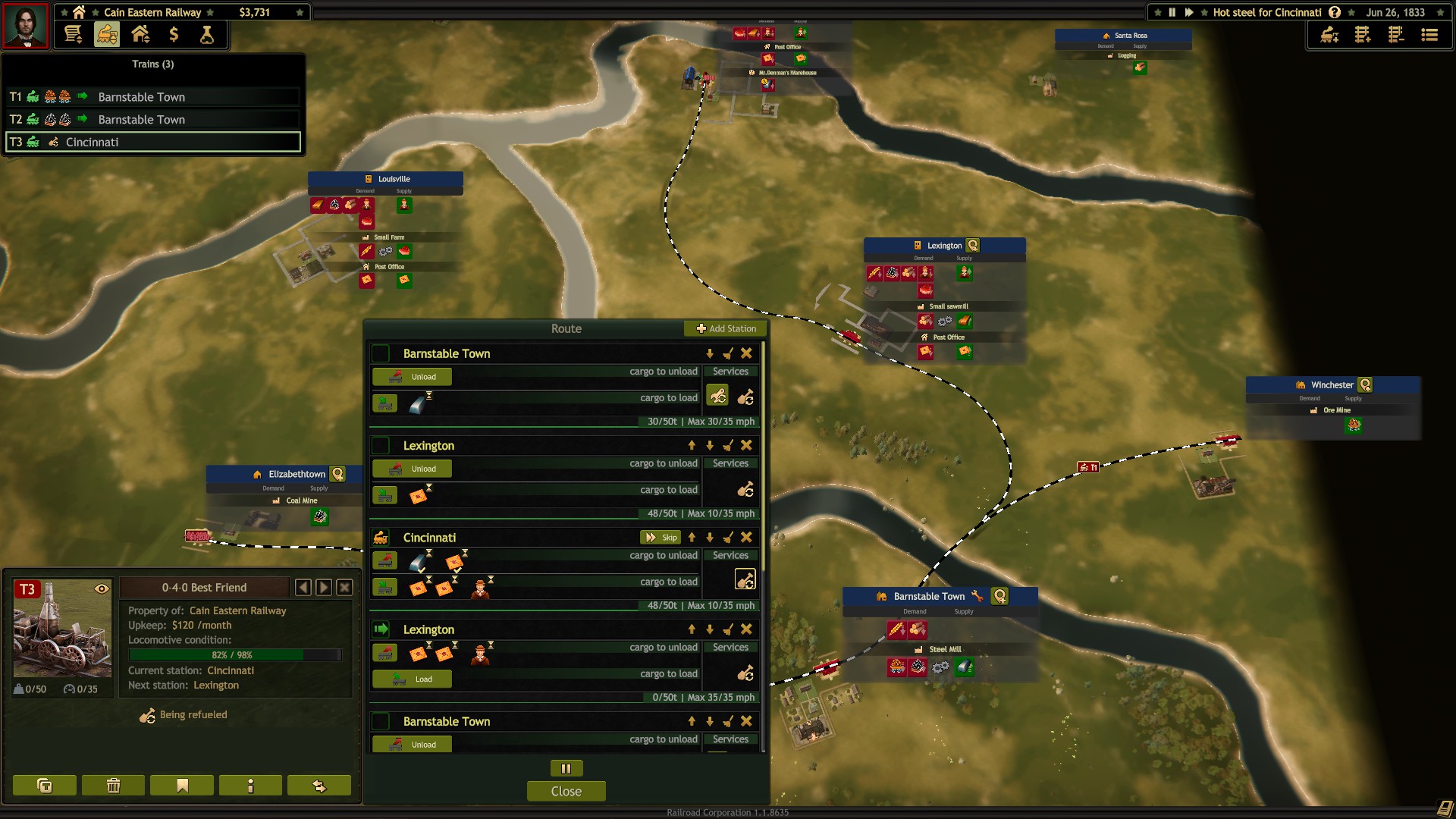
Finally, you need to schedule your trains. Trains (or, well, their crews) are stupid and will only do the exact things you have instructed them to do, so if you tell them to take on two passengers and then drop off one, they will keep that one leftover passenger for every trip, slowing the train down with its weight and gradually grinding to a halt.
One particular annoyance is that when you change anything, you have to make sure to remember to save it by hitting the apply button at the bottom, or you lose every change you made. Some of these schedules can be highly complex and take 10-15 minutes, and they get wasted if you forget this one minor thing. That’s not even counting the fact that you can hit the button to skip to a different station or that when you tell a train not to buy certain goods because you are in a budget crunch, the train will ignore those commands until you hit the apply button, potentially making you lose the game because you didn’t punch the button in time or thought that simply telling the train to do something without having to say “Simon Says” would make the train do something….
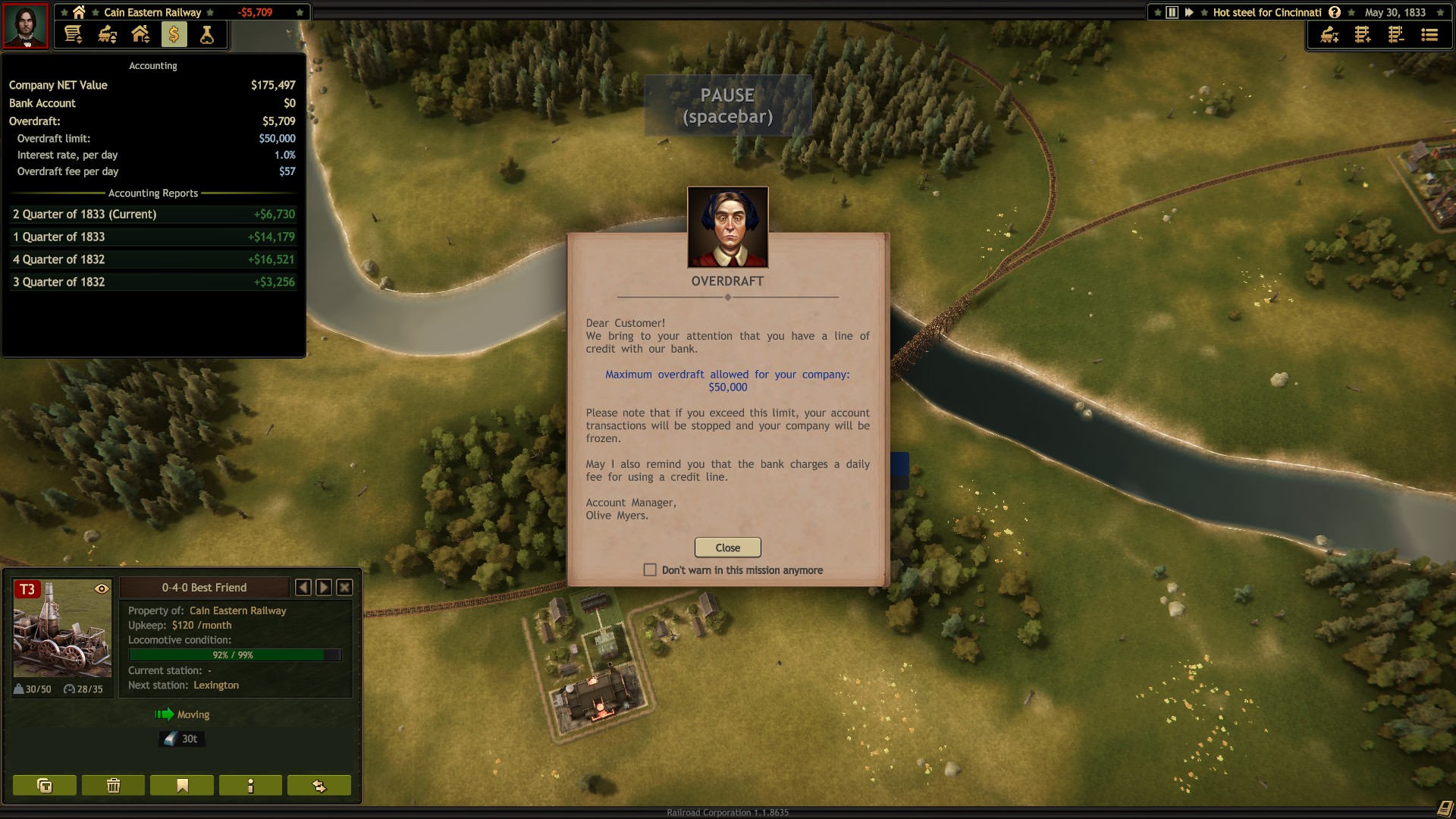
Trains also do not respect your bank account when buying goods. I had one surprise “gotcha!” game over that would put Train Valley to shame just because I had spent most of my funds expanding a rail line to a new town, only to have a train buy three loads of clothing for $20,000 each, throwing me to -$47,000 instantly, and you lose as soon as you hit -$50,000, it takes months for trains to reach their destinations and sell things, and you have to pay a DAILY 1% interest on overdrawn funds. Because no trains hit a station to sell goods in time, there was nothing I could do but reload a mission I had been succeeding at until that moment. (What? Keep lots of funds in the bank for occasions like that? This is a game all about expanding as quickly as you’re capable. Slow and steady loses the race!)
Also, you can name your trains so that they aren’t just “T2”, and assign them a color. You want to do this – you will eventually be juggling so many trains that you will have no means of keeping track of a train’s purpose without good labels. The only thing is, this game is strangely stingy with options in everything, including colors. It’s seriously just colors, but you only get five, and they’re severely limited in palette for no good reason. They are red, blue, blue-green, green, and yellowish-green. The yellowish-green and green in particular are close enough that they’re difficult to distinguish, making it fail at its one job.
While I’m on the topic of limited choices, there’s also four portraits you can choose from – blonde white man, blonde white woman, dark-haired white man, and dark-haired white woman. I guess Corbie Games is based somewhere cold enough they forget other skin tones exist. (Yeah, it’s unrealistic for a black man to run a company before the Civil War, but it’s even less realistic for a woman to do so, so the most likely explanation is Corbie simply didn’t remember or bother to add other options.) In sandbox or multiplayer mode there’s an option to link in your Steam avatar, but it doesn’t seem to work so it just defaults to blonde man even when you pick your own avatar.
Before going onto what’s new, however, I want to also list out the other major features that existed in Railroad Tycoon and Transport Tycoon:
Contracts are basically randomly generated optional quests that basically amount to being payed a lot of money if you complete a delivery of a set number of goods to a particular place. In sandbox mode, these are the only real objectives added to the game, although you can easily ignore them, and probably should early on.
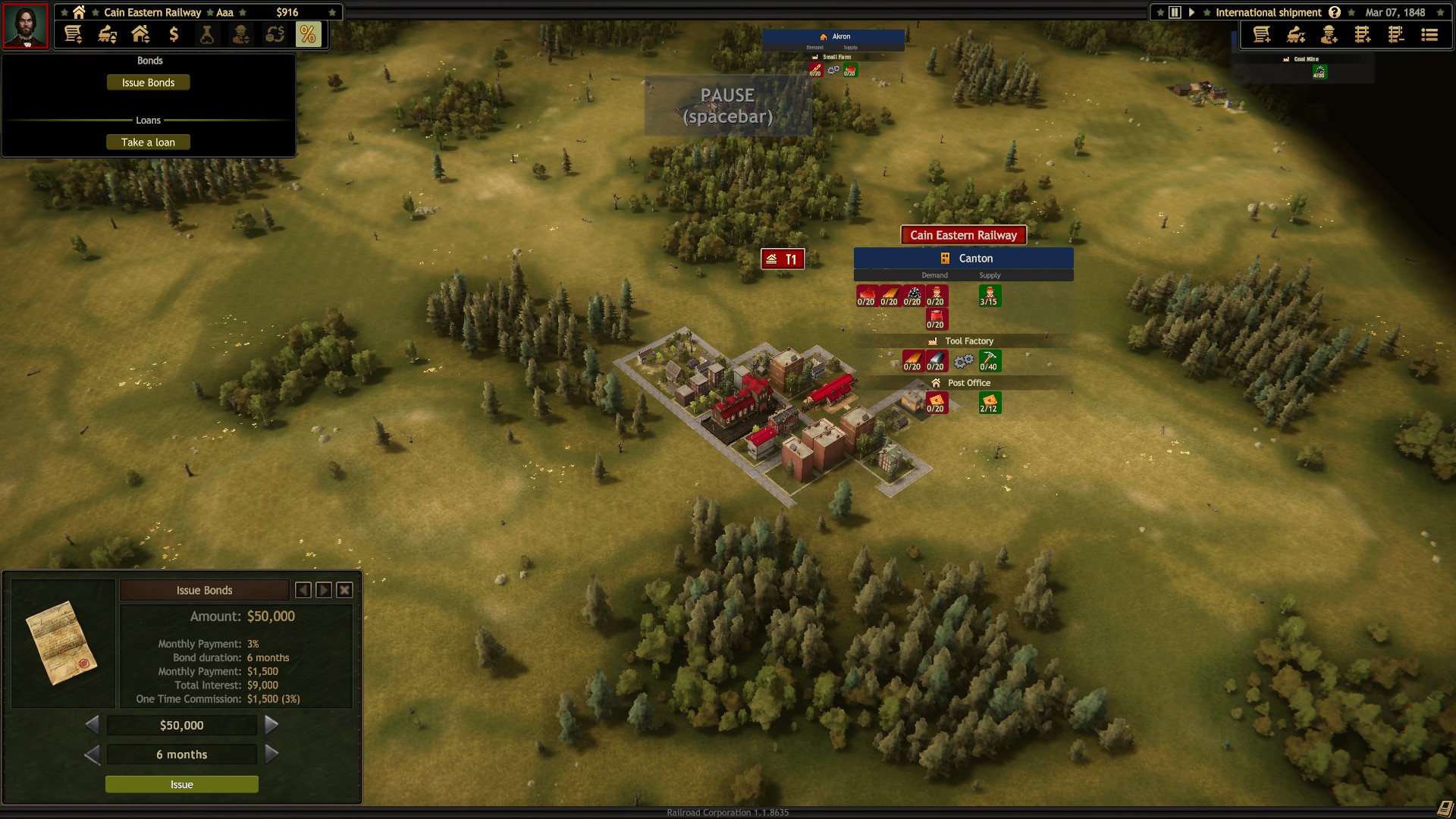
Loans can be taken out, but this oddly requires you have a finance office, which means that if you’re in financial straights dire enough to accept their ludicrous interest rates, you probably don’t have the money to build the bank from which you can take the loan. It basically exists for one mission where you start out with no money but a free finance office, and you never use it again because by the time you can afford one of these, you almost definitionally are making enough money to be able to just sit on your current profitable lines accrue more money waiting a month and then expanding on your own funds instead of paying the insane 79% APR interest rates to start a new line a month earlier.
Lobbying is a feature that basically lets you spend money to try to make random events more or less likely to happen. These events can be things like offering more money if you do things like delivering passengers to a specific town for a limited time. In general, there’s not much to think about here, just occasionally check up on it and push for things that are obviously to your benefit. I guess it accurately portrays lobbying in that regard – you’re only concerned with your own bottom line, and don’t feel any effects one way or the other about anything else.
New Features
Aside from the “it’s 3d”, what new things does Railroad Corporation bring to the table? After all, it needs to compete with the likes of the other Railroad Tycoon spiritual successors like Transport Fever or Railway Empire or Transport Fever 2 or A-Train or wow, there’s relatively a lot of these even without counting things that don’t fit the sub-genre like Train Valley or non-train forms of Tycoon games….
Well, the main innovation, besides that tech tree I mentioned earlier, is that in campaign mode, you get to pick perks that cost bonus points you get for completing objectives in previous missions.
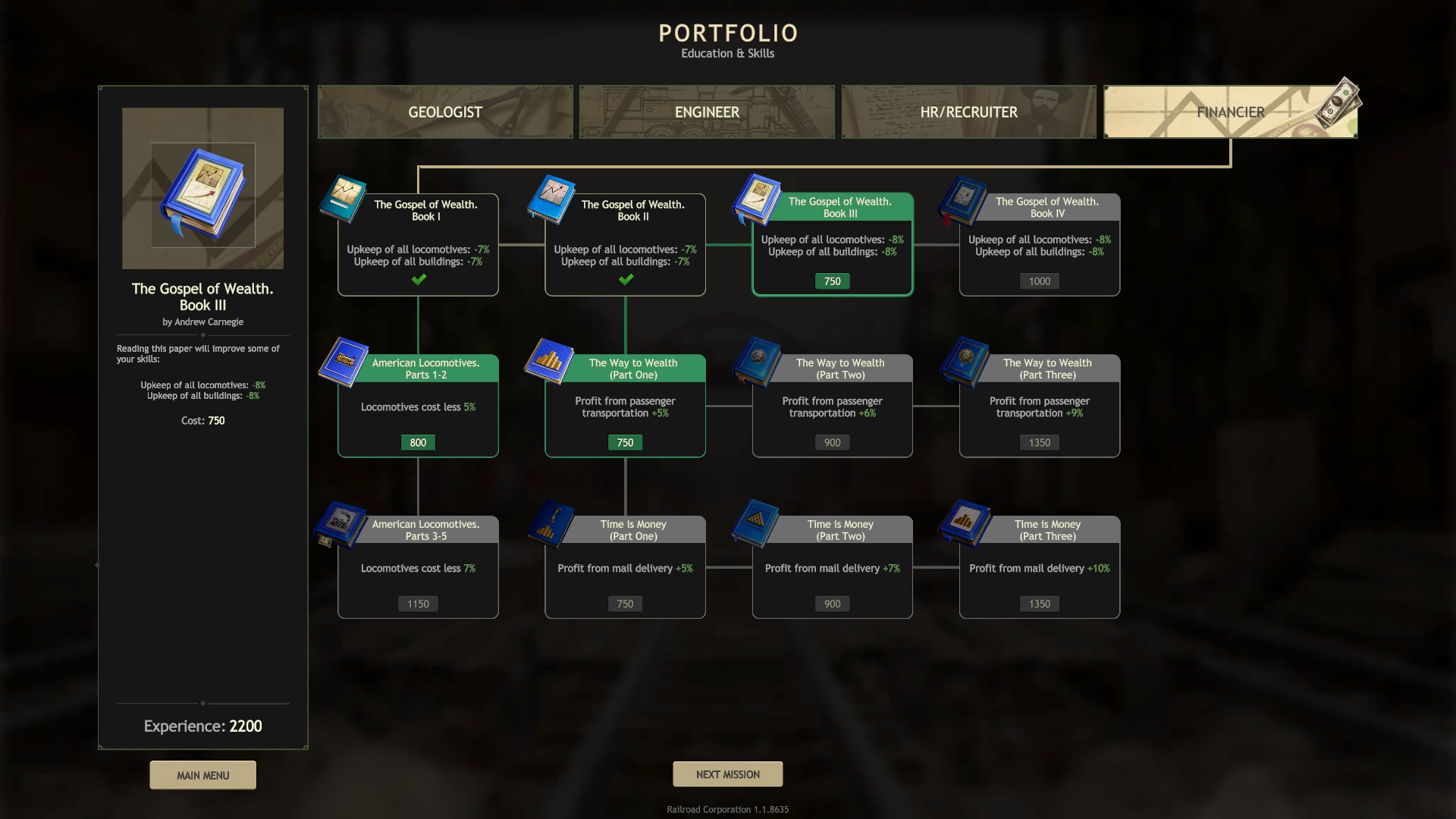
These can range from a 5% discount on the price of rails to a cumulative total of reducing the relocation costs of personnel you hire by up to 95% if you take the whole line of perks. They don’t seem particularly balanced in nature, as they suffer from that typical problem of subtracting percentages where getting another 5% off when you already have 75% off is actually reducing the price you are currently paying by 20%. Considering how many different stacking sources of discounts you can get including the personnel, by the end of the campaign, you may be able to get discounts up to or possibly even over 100%, but I haven’t seen that yet.
This brings up the other major difference between this and other games: Hiring personnel!
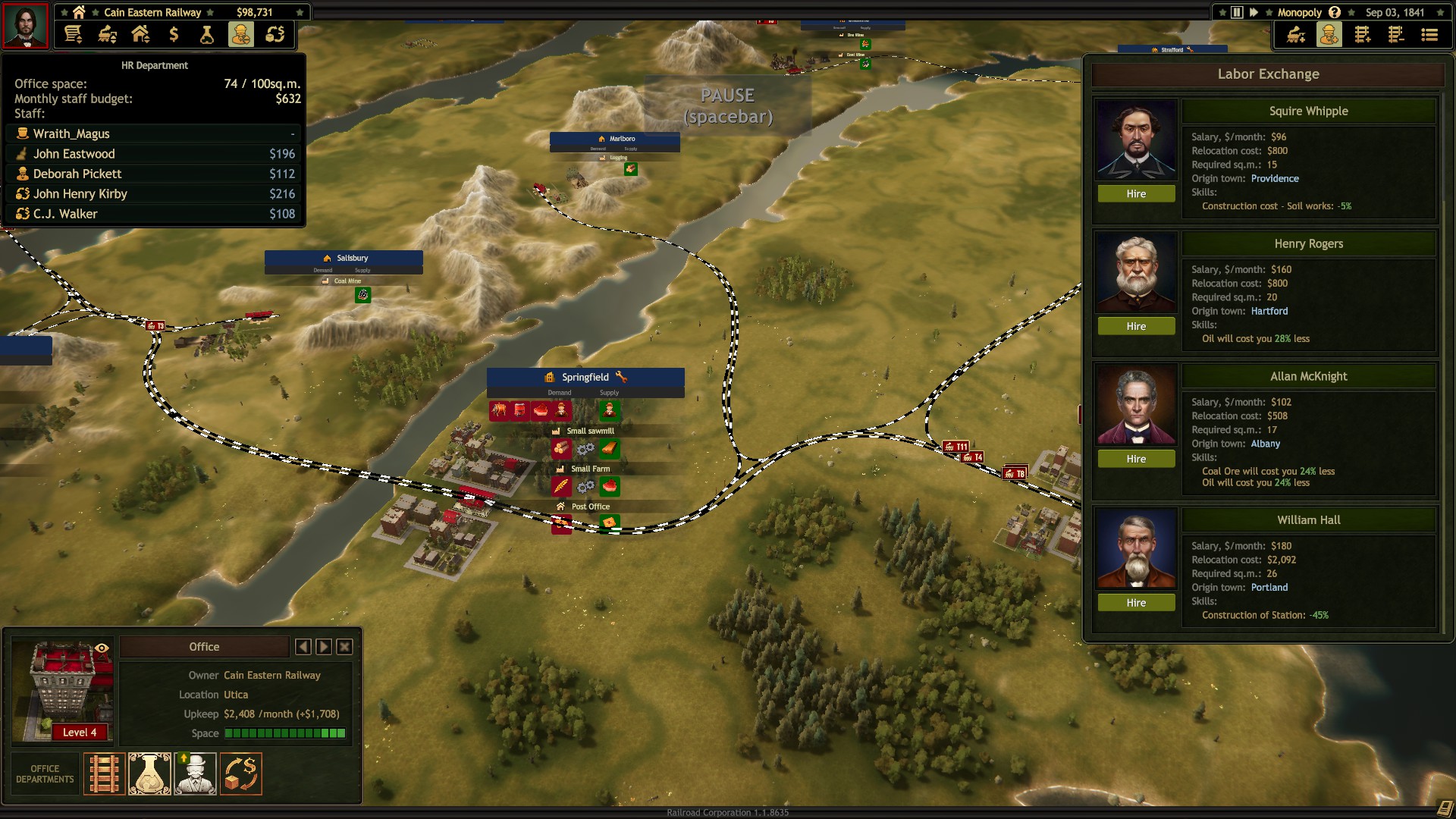
In your home office, you can upgrade the office to gain “rooms” you can fill up with upgrades like having an HR office. When you buy one, you get 60 square meters (this is oddly the only metric unit of measurement in the game) of office space. When the mechanic is introduced, your boss tells you to hire personnel for one function, then fire them as soon as they stop being helpful, and this is indeed a tactic you can employ – hire a guy who makes bridges cheaper just before you build a bridge, then fire him when you aren’t building more bridges. Personnel are paid salaries monthly and have a relocation cost as a hiring bonus, so the main impediment to a hire-use-fire-the-next-day strategy is that relocation cost that can be close to a year’s salary, but remember how I said that a chain of perks can drop this relocation cost to only 5% its normal cost?…
Anyway, salaries for these guys still only amounts to about $3,000 per personnel, and when you’re throwing around several million dollars in expenses for the trains, your office personnel expenses are trivial, especially compared to their benefits. Some of these guys can give you benefits like nearly half-off on specific commodities or specific trains, and they stack with any other discounts you get, which can be one of the few times I’d consider a specific type of train.
It’s also worth noting there is no real balancing factor in these characters. I’ve seen two guys I could hire – one who would be paid $400 per month and took up 24 square meters to give a 5% discount on rails while the guy next to him would be paid $300 a month and took up 20 square meters to give a 20% discount on rails. The only thing is that they become available invisibly and disappear after an indeterminate amount of time, so you basically have to be paranoid about checking the personnel page to catch some of the guys that give absolutely crazy discounts.
While it’s powerful, however, it’s not terribly strategic or engaging. It’s basically a reward for getting lucky and remembering to look when someone really good applies for a job. Once you have someone that gives you massive discounts to something you want to buy, you might as well get married to them, but outside of endless sandbox missions, you’ll just have to hope you get lucky again next time. If a mission is really hard, it would be annoying if these guys are actually the difference between victory and defeat just because of how luck-based they are…
There’s also a feature I don’t think I remember seeing anywhere else where you can set up a warehouse that magically teleports goods onto the global market. Hypothetically, these are being sold overseas, but you don’t need to be at a port to do it, and you are the only transportation company in town, so how do these goods get bought and sold instantly? Oh well, who cares, it’s completely worthless as a feature goes because warehouses can buy goods initially for cheaper than the market value, but they rise in price every time you buy something so in a game about sustained growth, it’s useless. You can also sell things to the global market, but the prices are even worse and only drop from there as you sell. You can buy to raise the price and then sell at the higher price, but the sell price is a percentage of the buy price so you’re losing money on each transaction, sucker. It also requires manual control to do anything while everything else that actually makes you money is automated once you set it up. No thanks.
I guess I can also mention as a “new feature” that unlike Railroad Tycoon or Transport Tycoon but like Train Valley, the game has TARDIS/clown car train stations. A rail station only has a single track inside it (even if there are multiple tracks leading into it, they pinch into a rail station singularity. Rail stations can hold an infinite number of trains and cars, and can easily hold trains much longer than the station itself. Trains whose engines touch a station suddenly have their following cars get a burst of acceleration as they get sucked up into the station’s event horizon.
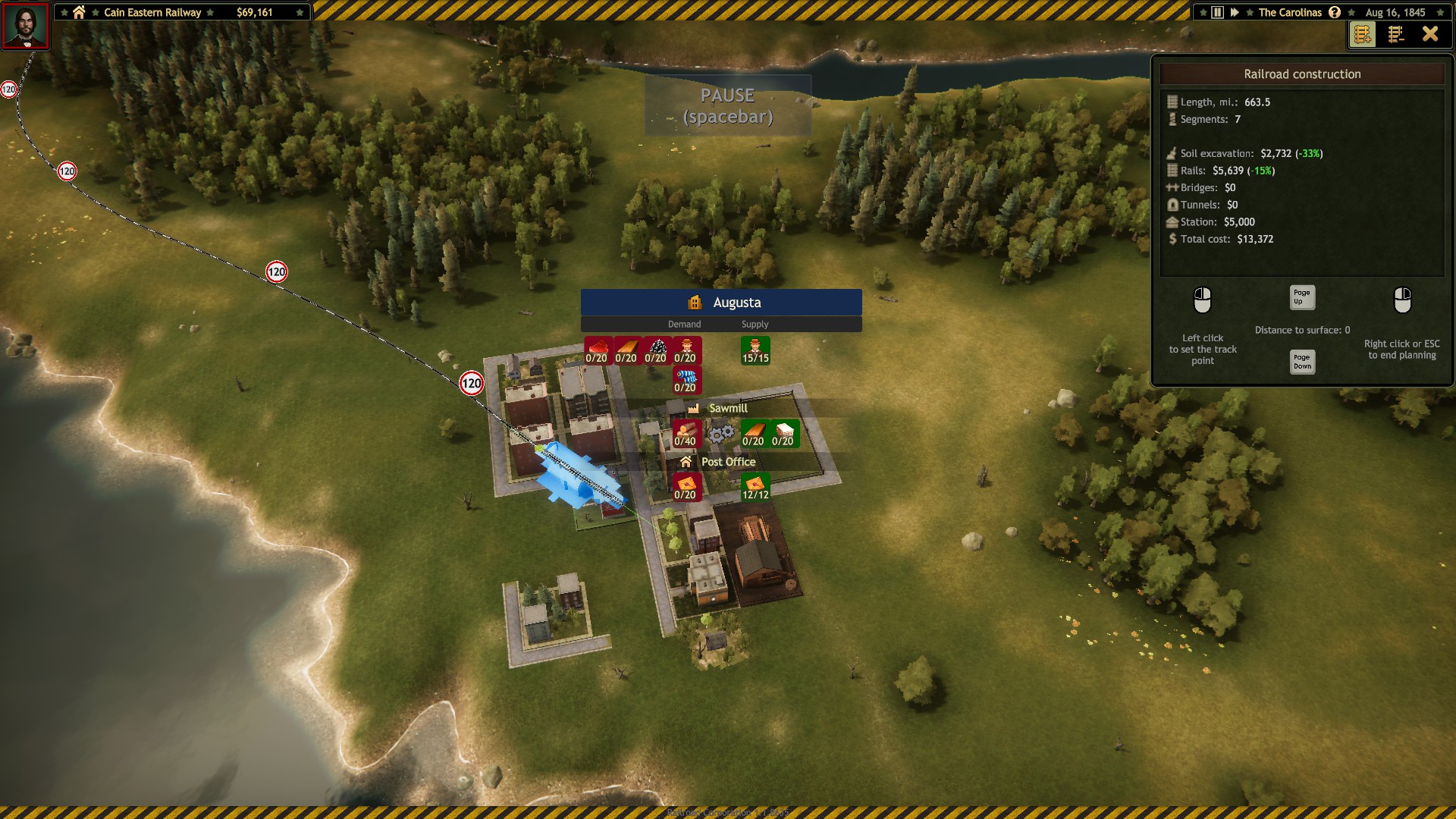
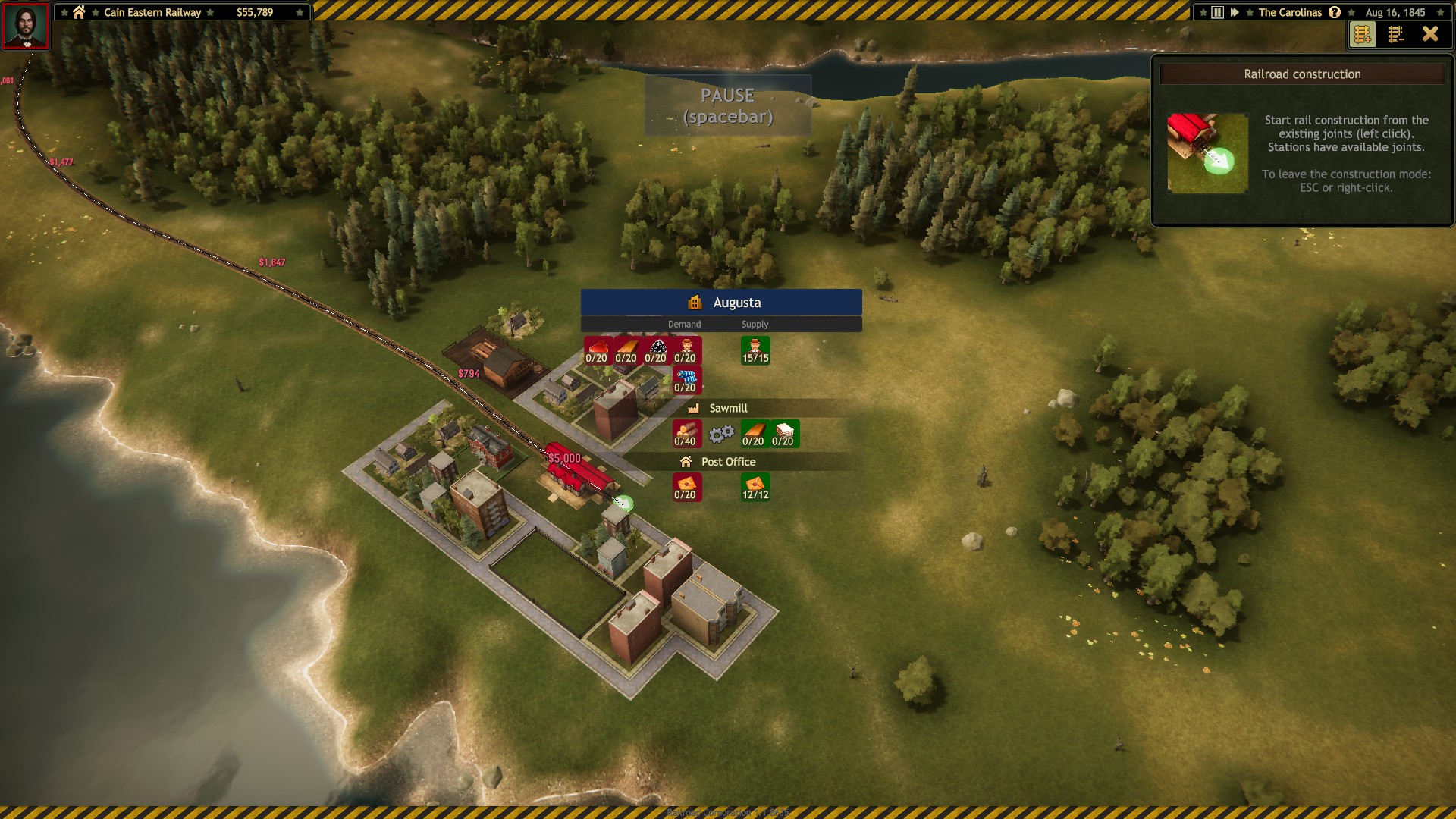
This extends to building stations, themselves. Stations can only exist in the middle of towns, and towns will be totally rearranged for free whenever you build one to accommodate your station and any rails you might build. Feel free to bulldoze straight through people’s homes! They won’t mind!
By comparison, Transport Tycoon cities would be a major obstacle, and not only did building stations near cities become a major problem, as supplying cities with needed goods leads to the expansion of the city, but demolishing buildings costs lots of money and has a significant negative PR to the point where you can be kicked out of a city for too much demolition. You need to claim land early with an eye towards what you will need in the future. You know, apply strategy in the strategy game? Nah, don’t need that, let’s just have magic rearranging cities!
Finally, cities growing in size is not really “new”, but implemented in a different way from Transport Tycoon (where cities actually built buildings that took up tiles on the grid as it expanded). Cities have populations. (You can’t see them unless you close all other menus and click on the name of a city, though. There are no instructions that tell you that you can do this, so it was only after a mission where you need to expand a city that I realized you could do this.) Trading goods they need to cities or buying from their factories gives them an expansion of their population, and over time, they will change the products they need to consume. Tiny hamlets have no demands but can have a single factory, like a lumber yard out in the forest that only has a population of 250. As a town grows to a population of 1000, however, it starts to need basic resources like grain and wood. From there, it gradually gains more high-end expensive products it will buy while dropping the lower-end resources. I personally prefer the actual creeping city structure of Transport Tycoon, but this dynamic city demands idea really helps keep you from being complacent once you have set up a schedule for trains. You set up rails to connect coal mines to a town, but then it outgrows the need for importing coal, and you have to build rails to send that coal to the next city that will still buy some. The increase in size also makes city slots that allow you to buy your own factories (that turn raw materials into intermediate or finished products only, you are dependent upon existing raw materials as a basic challenge in the game’s concept), while at the same time demanding that you build more and more advanced products to supply them. They start accepting wood, but then stop taking raw wood and instead demand timber planks you get from taking wood to a sawmill, and then stop taking those and instead demand furniture that is made from textiles (made from cotton) and timber in a furniture factory. This expansion means that you cannot rely upon a raw material like grain providing you with easy money by delivering an abundant resource to a nearby market for long, and that you need to work harder and harder to connect raw materials that can be far flung apart from another. In a genre where you typically face a challenge only at the start of a mission (because once you start making money, you have no reason to stop making money unless an outside force dries up existing business opportunities), having a mechanic that naturally ramps up the difficulty with time helps keep things interesting.
Story/Historical Context
The game does try to paint the picture of early locomotive “Robber Barons” of the railways. Your boss is a greedy, corrupt man who will fire you at the drop of a hat, and demands you be the same, encouraging you to hire and fire your own employees on a whim.
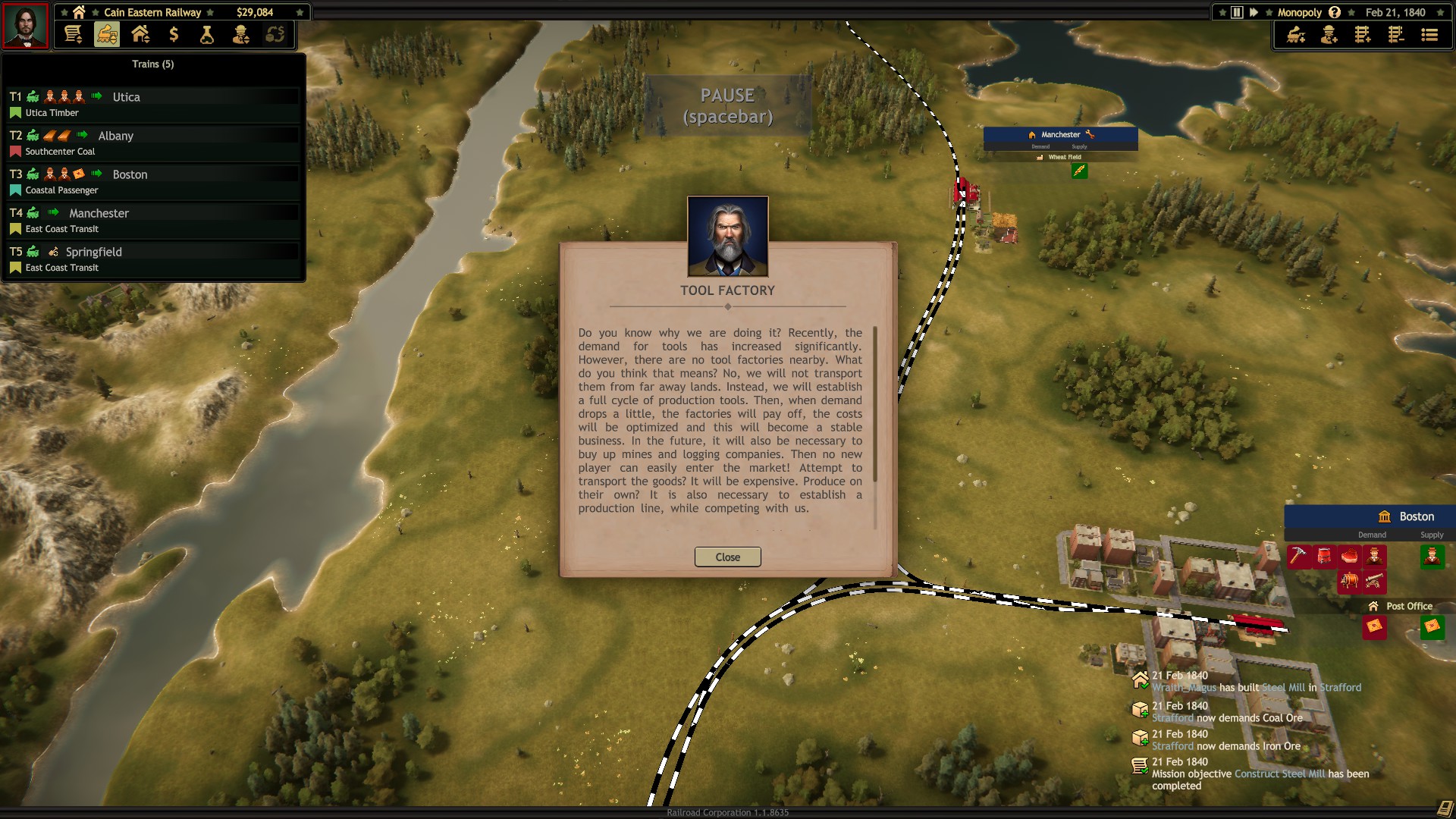
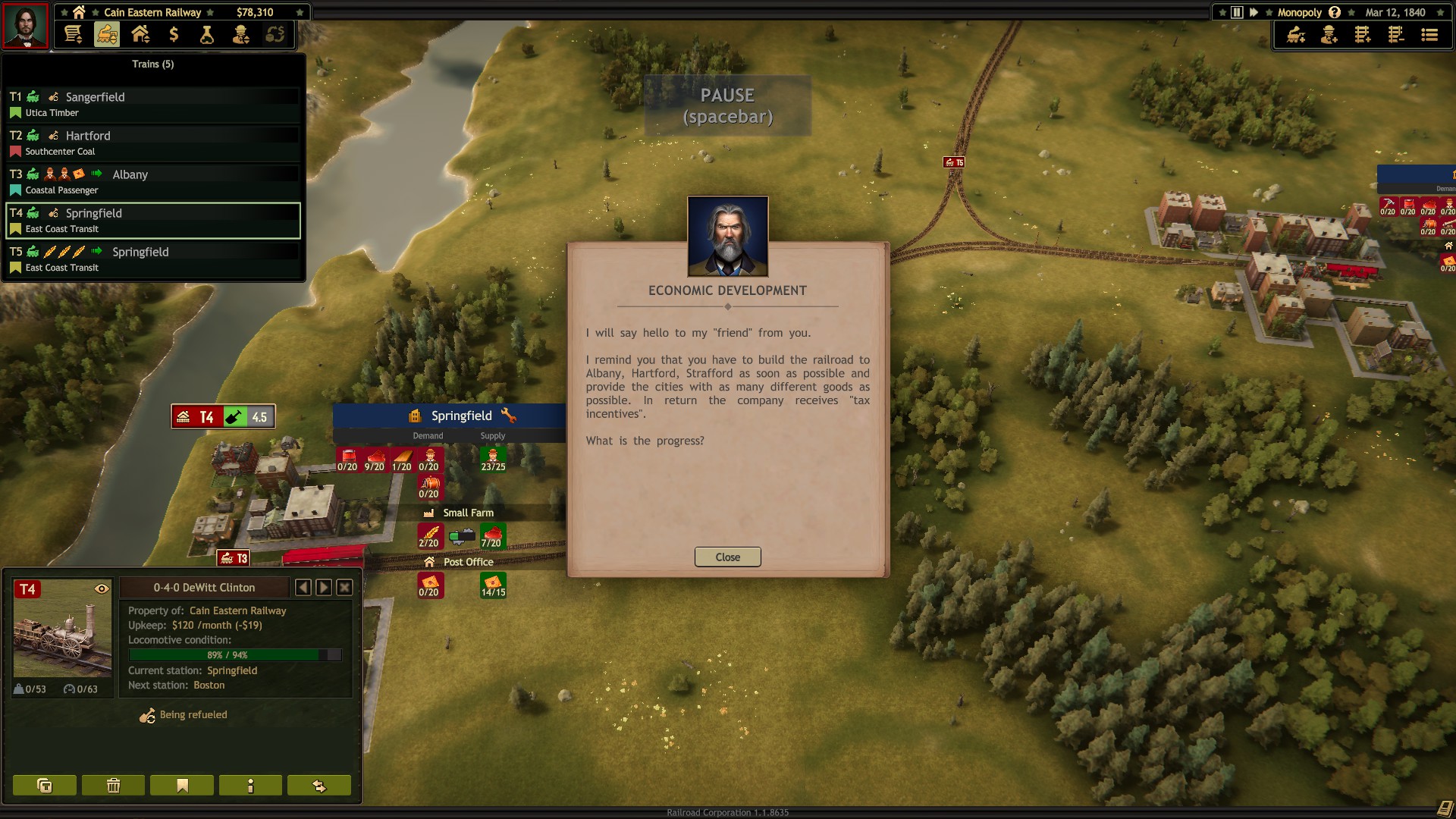
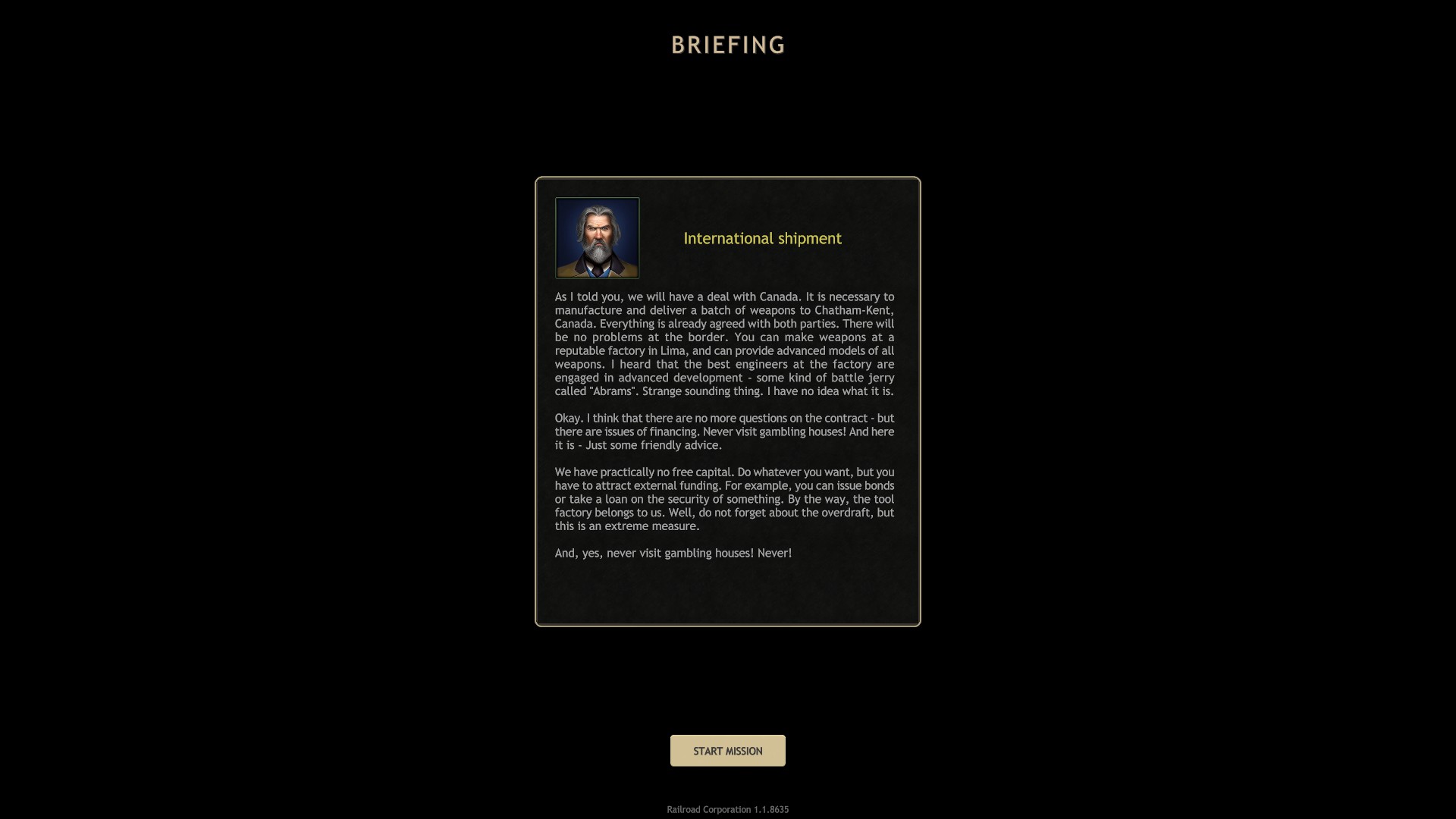
If you click on those images and read the pop-ups, you’ll probably notice that this game seems to be written by people who don’t speak English as a first language and either can’t or didn’t bother getting anyone who does speak English fluently to proof read it. It isn’t unintelligible, and it isn’t filled with missing articles or other clear tells, but the sentences just aren’t structured like English speakers speak or write.
The game takes place in the early age of railways, meaning that there’s an excuse for you to be building the first rail lines in an entire region like New England. Only something of an excuse, though, as missions are about 3 years long, and railways were built earlier and later than this spread out over greater periods of time. It’s also set during the leadup to the American Civil War, which makes the fact that one of the finished products are cannons that you can ship to places like Boston, Massechusetts or Charleston, South Carolina feel a little strange if you think about it for just a second, since you’re all but openly altering the course of the war that’s about to happen based upon how you build the infrastructure of the North or South but the game doesn’t seem to notice or comment on this idea at all.
That said, while the game seems to be fine with highlighting the corruption of the practices of early robber barons at least in pop-up box form, or in the names of your personnel perks like “The Carrot for the Manager, the Stick for Workers”, there’s never any actual negative consequence for any of it. (At least, not in the parts of the game I finished before writing this review…)
The game doesn’t really touch on it, either, but did I mention that you are tasked with connecting cotton-producing towns in pre Civil-War South Carolina with the textile mills? It’s odd that the game wants to paint the train tycoon as a kinda-sorta villain who cares about money above all else, but pays no attention whatsoever to this part. There’s something a little unsettling when you’re looking at a map and watching schedules and ledgers only to realize what would actually be going on in those cotton plantations and that it actually took you staring at a map like this for half an hour to make that connection…
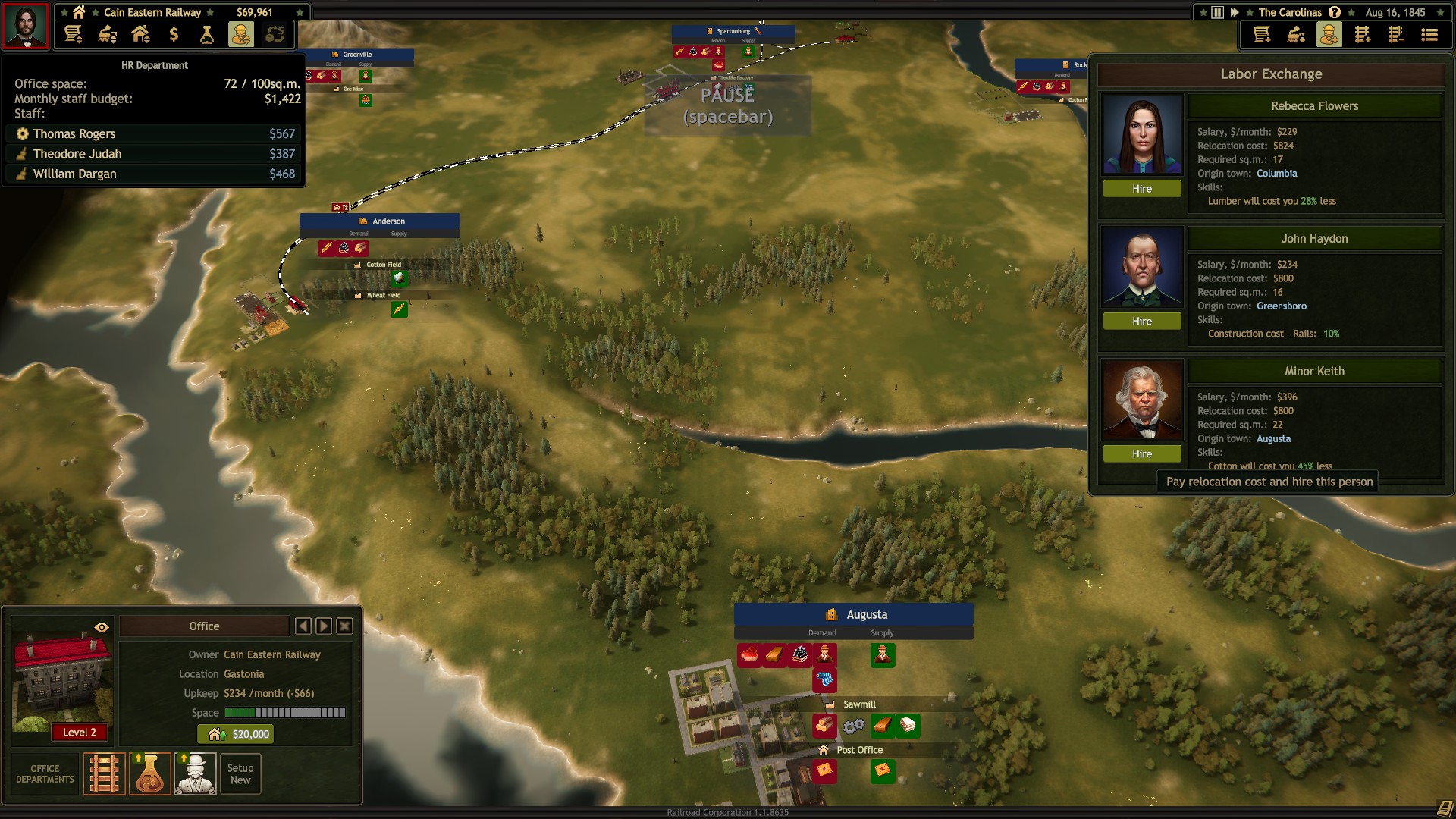
Interface
It’s bad. It’s really, really bad.
Normally, I like to start off by pointing out that this game commits a cardinal sin of not having rebindable controls on a PC game, but that’s putting the cart before the horse in this game.
Apparently, the people at Corbie Games are allergic to keyboards, because this game doesn’t even have controls to bind. Seriously, any other management game would take all those tiny buttons along the top of the UI and give them bindings to something like number keys, or if those are for game speed, put them on the F-keys. Nope, nothing. Use a mouse. There are only buttons for camera controls (and Q and E for rotate just feels wrong) and even then, rotate and zoom in/out were only added in the most recent patch after the game supposedly left Early Access. The only other grudging concessions to user control are that escape closes windows or opens the menu, F5 is a quicksave button, and the spacebar pauses the game sometimes, depending on what menu you are in or what windows you have open at the time – if it just makes a window disappear, just try panicking and slapping the spacebar until the game feels like stopping. I hope you weren’t trying to pause because you needed the game to stop before something really bad happened, sucker!
But don’t worry, interface problems aren’t just limited to the controls! This is also one of those management games that have a really complex economic system while giving you nothing but the most absolute bare minimum of information on the things you are doing! You can see a quarterly report on how much money you spent buying raw materials and how much you sold them for over that quarter, but if you see massive differences between one quarter and another in how much you spent or earned even when you don’t remember doing anything different for that one quarter… well, tough luck, the game is going to give you absolutely zero help figuring out what happened. I guess you’ll just have to babysit every single train in a rail line that can have dozens of trains running at once to watch every single transaction to see where your money is going. Don’t even try to keep track of how much money you make buying a farm and paying upkeep on it compared to just selling wheat to it and then buying the leather, because you’re basically going to have to keep detailed notes on how long it takes every train to make every trip to do that, and there isn’t even a marker for distance past the rail-laying screen.
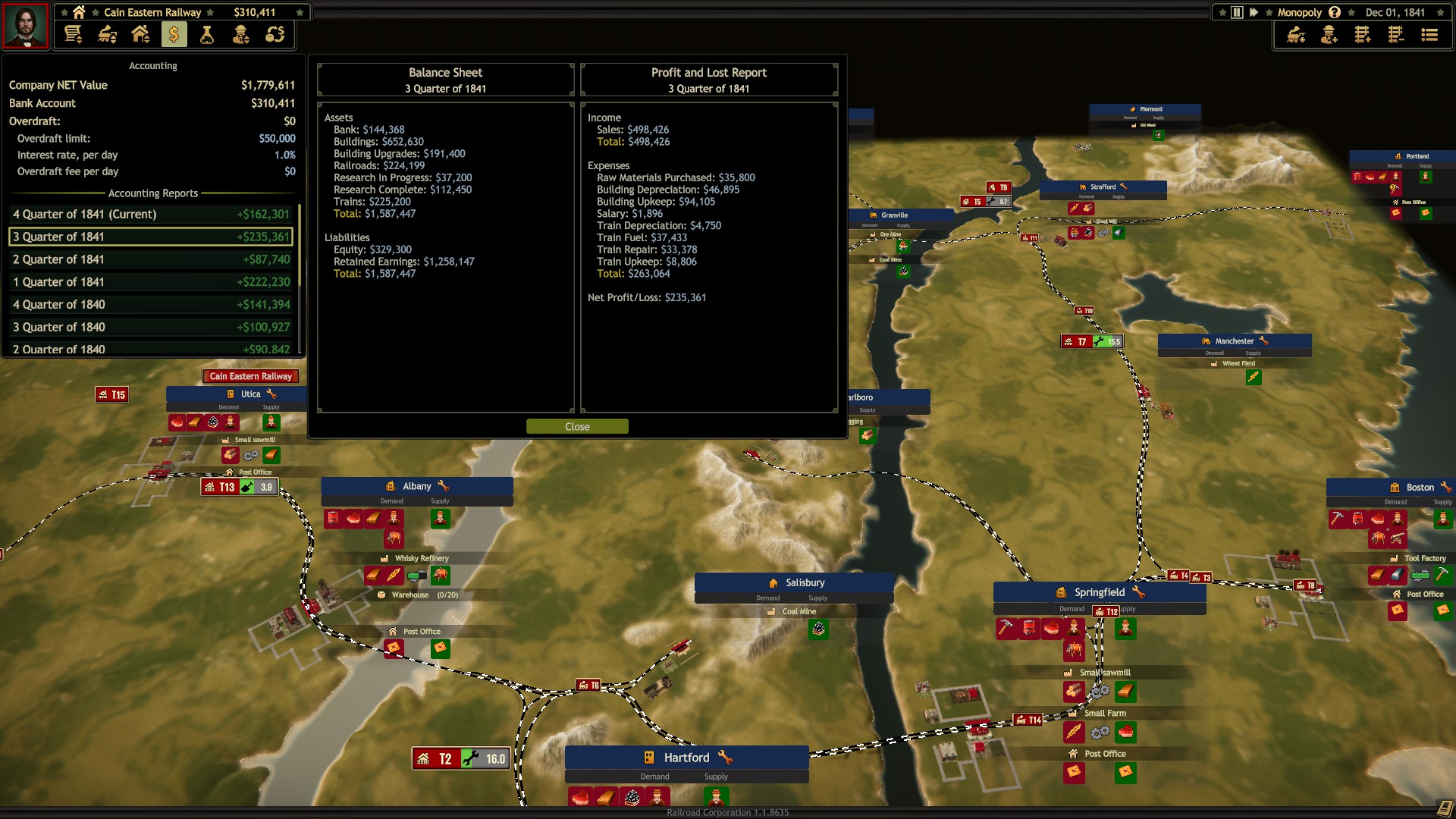
You don’t even get the old lazy standby of management games that have no idea what information is actually useful for players, the line graph!
Hey, Corbie Games, if you’re reading this, add a page that shows a breakdown of all the expenses and revenues that a train or a station has incurred to each train and station, with a breakdown on what goods cost or made what amount of money so that we can actually follow up on the efficacy of our decisions.
But wait, that’s not all! The utter contempt Corbie Games has for users having any control over their game doesn’t stop there, oh no!
Probably the most frustrating aspect of the Interface is the utter lack of capacity for players to stop, force the start, or order any of their trains to go in reverse. This is mainly important for many of the bugs, turning what would just be an annoyance in other management games into a game-breaking bug because if a train is stopped and refuses to go and creating a traffic jam, there is literally nothing you can do about it besides reloading a save before the problem happened. Did I mention that the game only autosaves every game quarter, which is generally like 2-3 hours of gameplay? Imagine losing 2-3 hours of gameplay about once per mission just because the developers didn’t bother to put in a simple, basic feature that existed in the game they’re clearly copying, and you start to see why the interface honestly starts to ruin what would otherwise be an OK game.
Honestly, nothing about the interface is user-friendly in the least, and I haven’t even started talking about the snapping mechanic in the rail-laying screen that seems designed specifically to spite the player.
No Manual
OK, major gripe number two has to be that the game has no manual and the “tutorial” is a half-dozen pop-ups that occur over the course of the first two missions.
Let’s take, for example, the sudden drop-off in train speed when you load up a train to near it’s max pulling weight; At about 80% max pulling weight, the train will still go at about 60% of its maximum speed, but around 95%, it drops to about 20% of its max speed. Basically, whatever a train says is its max capacity is a lie, you have to stick to about 75% of capacity or else you lose enough speed that it doesn’t make up for hauling more to market. There’s nothing in the game that really describes to you how this works, however. You just have to notice the speed indicator on the train’s schedule (whose significance I did not recognize at first), and play around with it until you get a feel for the drop off by testing different loads.
Also, remember that talk about the personnel hiring menu above? Well, that menu is accessible only through a button on the top right panel that doesn’t even exist until it’s unlocked. When the game tells you about hiring personnel, I could add the HR office through the top-left panel, and see the personnel menu, but couldn’t hire anyone. It took me several hours to realize there was an entirely different menu for hiring personnel that you couldn’t access through the menu to see current personnel, and nothing in the interface clued me in this tiny button was now also added into the corner of the UI.
So then, while playing this game, I had game overs twice (not counting having to reload because of a game-breaking bug). One was that surprise because the trains bought a sudden rush of expensive goods I mentioned earlier. The other was on the first mission (after the tutorial) the first time I played.
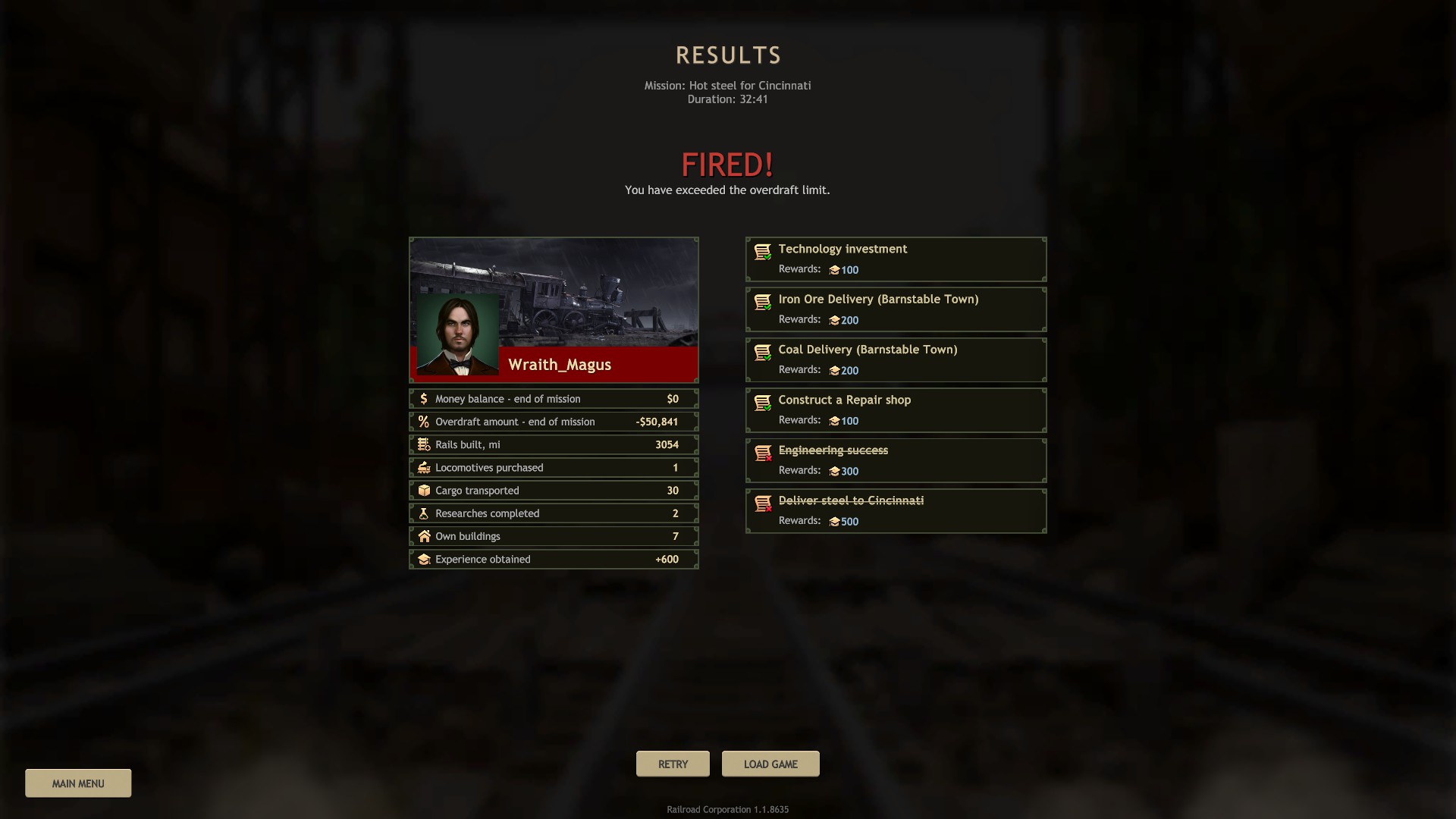
The mission introduces laboratories, but at the time, I didn’t want to put down the $15,000 for a building that didn’t directly pay off when I could barely afford trains and rails. Hence, I just set off with two trains trying to deliver goods, but I barely managed to more than break even, and the trains were painfully slow. (It doesn’t help that I didn’t yet realize that threshold for weight limit.) I eventually decided that since I had the capacity to overdraw, I should probably just go ahead and go into debt to buy a rail line that would go up to my objective because I was spending too much time trying to make money, and I figured I’d make more money getting to the next destination. That’s when I learned you have that absolutely criminal (no really, it’s illegal in most countries) 1% DAILY interest rate, and if I was only barely able to tread water when I wasn’t paying interest on a debt, there was no chance at all I’d survive with a devastating compounding interest.
So, restarting, the first thing I did was build that laboratory and research the maximum load upgrade for the Best Friend train. That upgrade is just enough to be able to carry two loads of iron ore in a single trip, which is a key threshold in being able to make a profitable run for the coal you’re burning to get to town. It’s also something I’d been given no idea to prioritize except through the school of hard knocks.
After that, I easily breezed through most of the game. Outside of the initial crunch, or possibly being low on cash from major construction to connect a new town to my existing rail line, I never had trouble making money again.
Why did I make so much more money in other missions than the first one? I have no idea, I really wish the interface would tell me things, so I could figure it out. I think it’s just how powerful the upgrades to the initial train really are, however.
I do have to mention that there are a couple user-made guides and a user-made wiki. The wiki in particular is really bare-bones at least at the moment. I’m a little reluctant to say that the game is saved by these, however (especially since the explanations aren’t great, anyway), as it is made by the users, not the company, and even if a game like Dwarf Fortress basically makes it mandatory you read the wiki, at least Dwarf Fortress tells you about the wiki in-game and says it’s the substitute for a manual, while you need to go looking in the forums to find the wiki in Railroad Corporation. Railroad Corporation combines a skeletal interface lacking many key critical features with unintuitive controls that are often bugged and do not update properly with giving the player absolutely no help in figuring out how the game works, just leaving it to the other players to do their job of explaining the game to new players for them.
Snap rail construction decisions.
By far the worst part of the game outside of the bugs and the rest of the interface is the rail-laying interface. How bad is it? Well, as of writing this, two of the four user guides are tips on how to pixel-hunt for the tiny few positions you can put down tracks that aren’t ruined by the overzealous snapping feature with slightly better regularity.
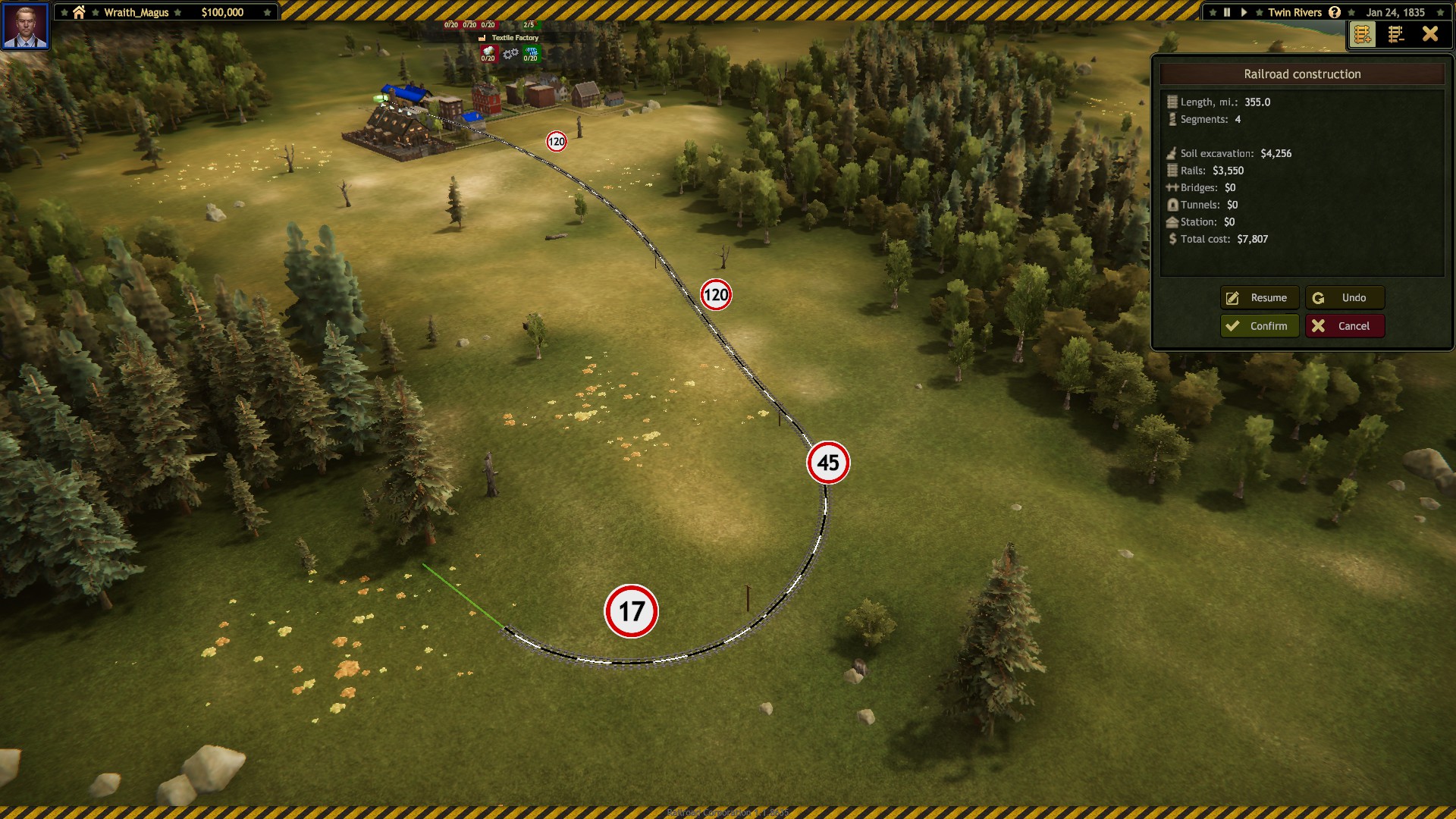
The picture above is a basic idea of how rails are laid out in the rail menu – each one of those speed signs indicates a different segment (if a curve in any part of a segment has a sharp curve, the whole segment slows the train down to the max speed of the sharpest part of the curve), and each one of those posts is where I clicked, specifically.
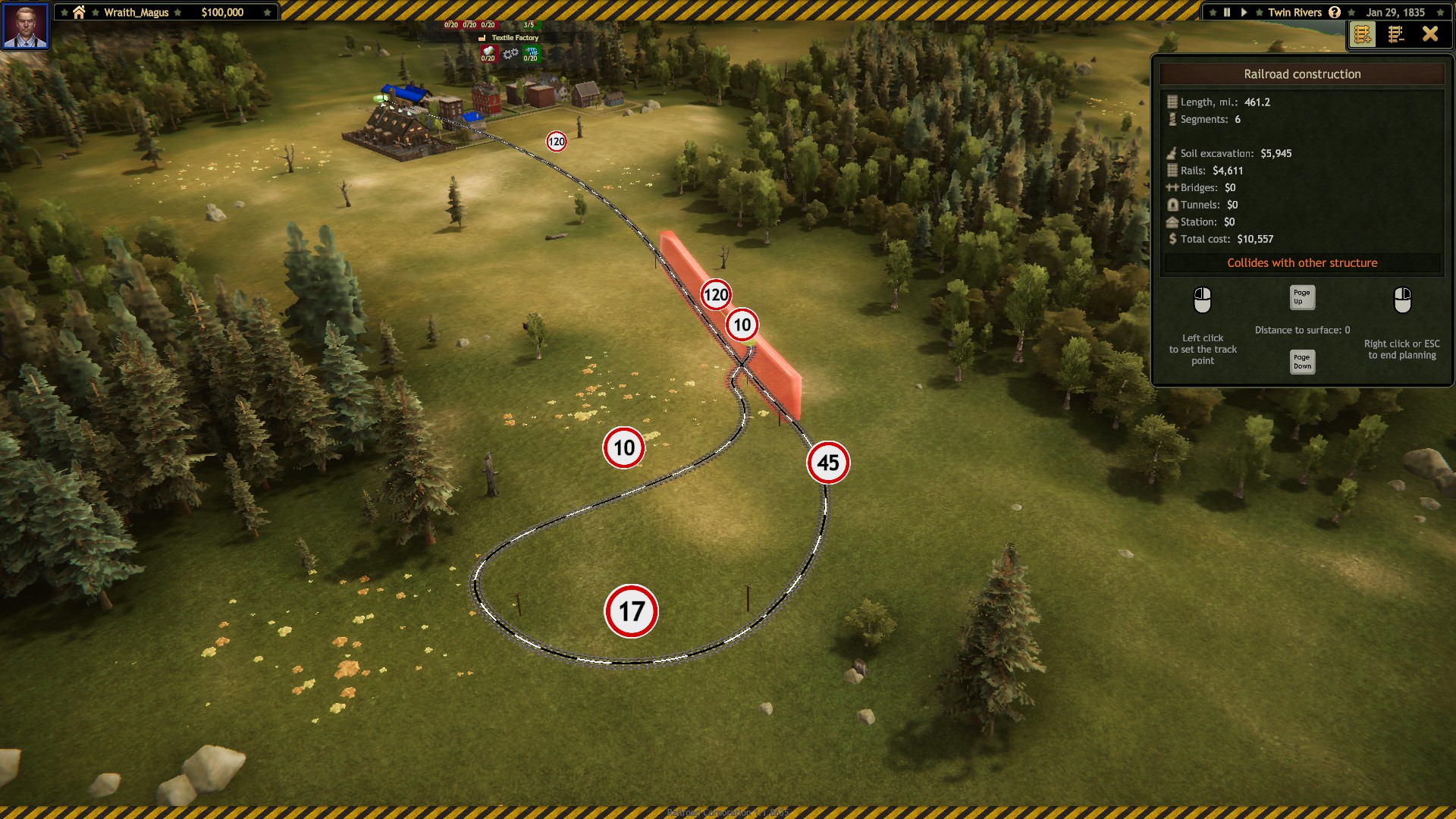
When laying down rails, there is a tendency to snap to paralleling a track that already has been set down. There is also a more powerful tendency to make tracks merge into a switch, even/especially when you are trying to take advantage of the parallel track “gravity”. On top of this, there is a overwhelming preference to have very sharp curves in creating these mergers or splits that cripples the speed of your trains. You want to avoid these slowdowns or at least keep them above at least 30 mph just to keep traffic flowing, but everything about the game’s systems fight you every step of the way. You can seriously spend 20% of your game time just pixel hunting to try to find some pixel, any pixel that will let you lay the track where you’re clicking, not where the game wants to force you to send the track.
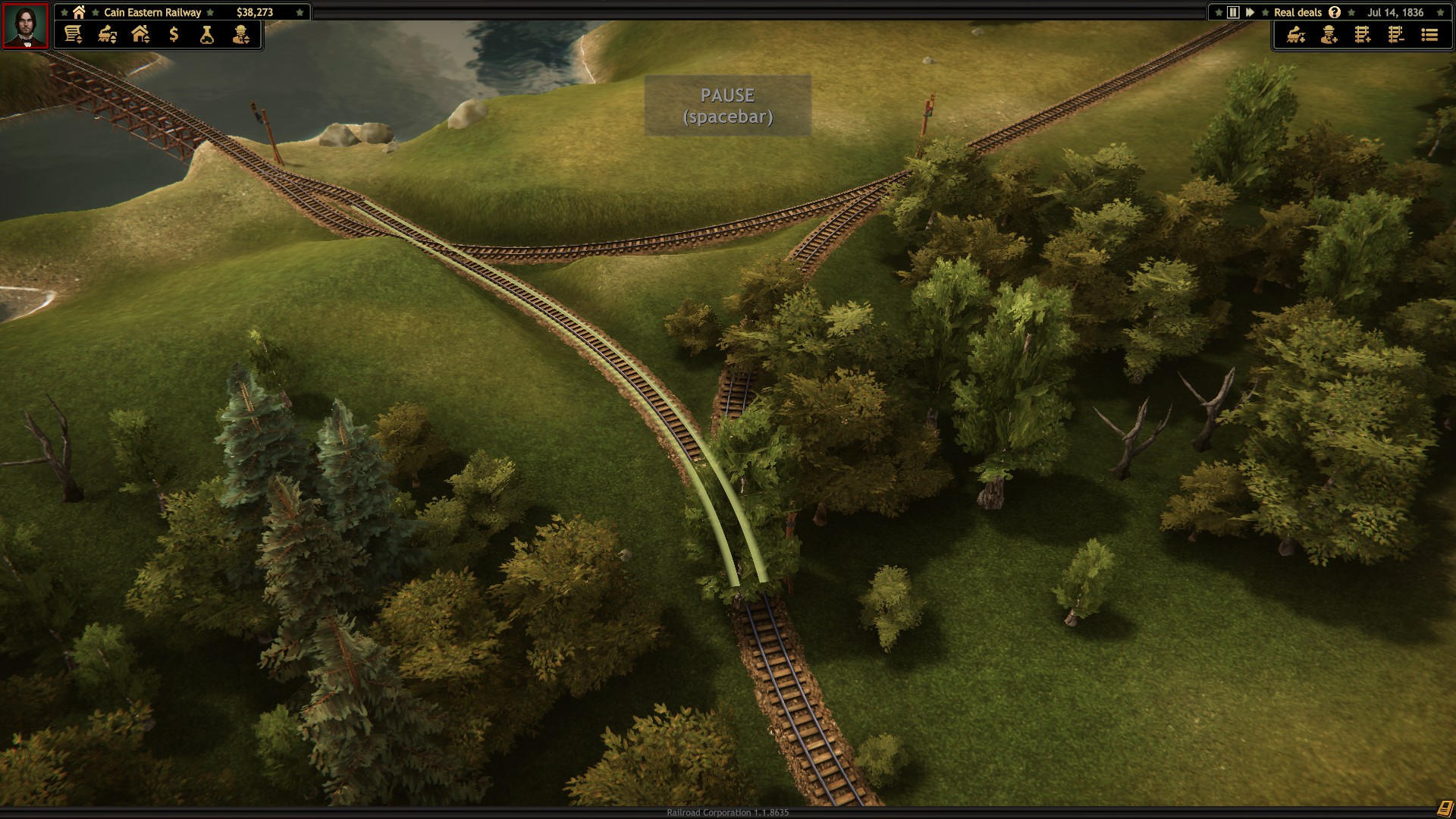
In general, you cannot cross tracks (the AI couldn’t handle it, anyway) except by merging or splitting tracks in a switch, although sometimes, the AI thinks the best way to turn left is to split to the right then cross over the existing track to the left for no good reason.
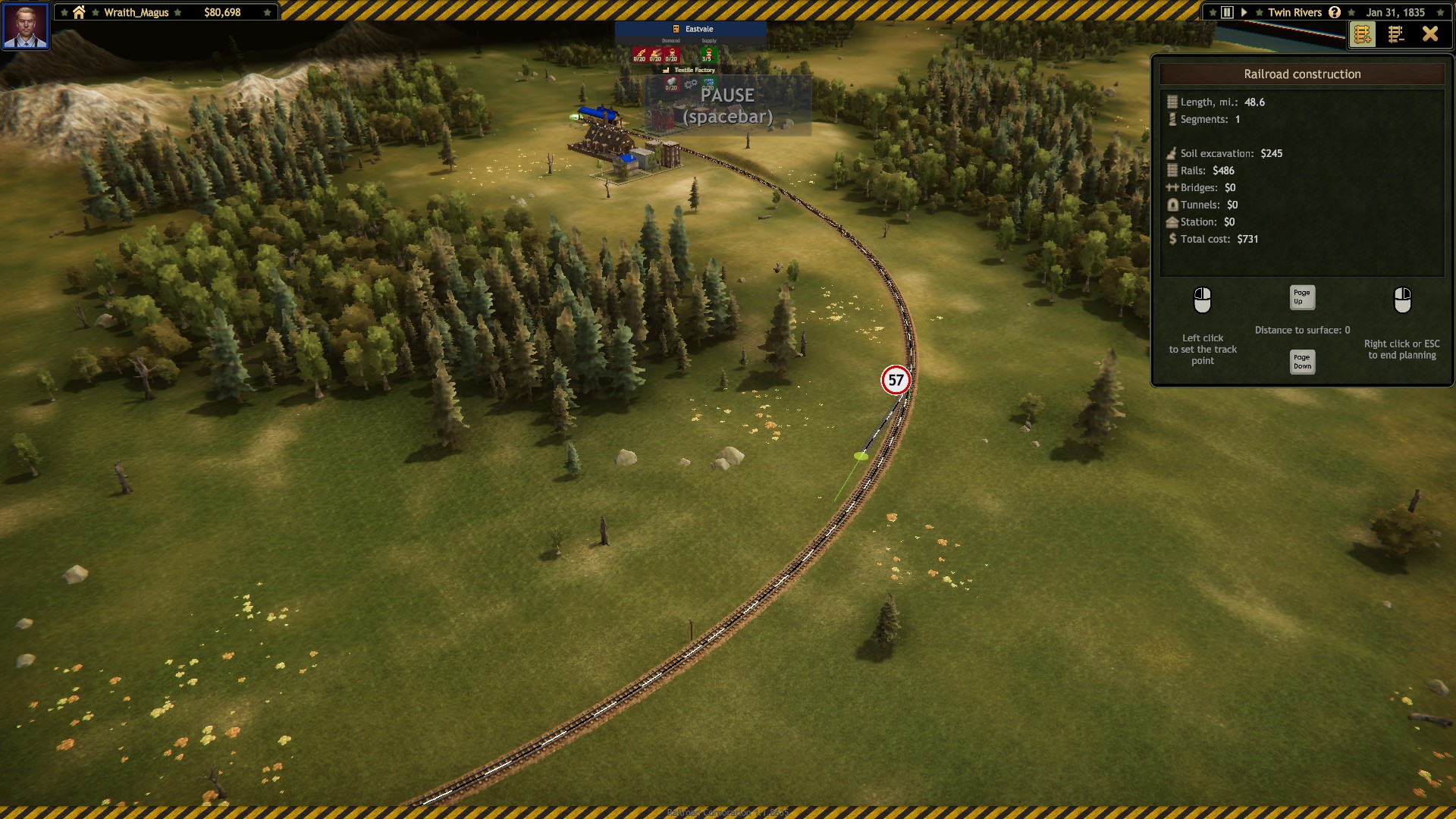
It is possible to make a split that doesn’t cripple your train’s speed to 11 mph, but you need lots of space to do this, and that can be a liability because…
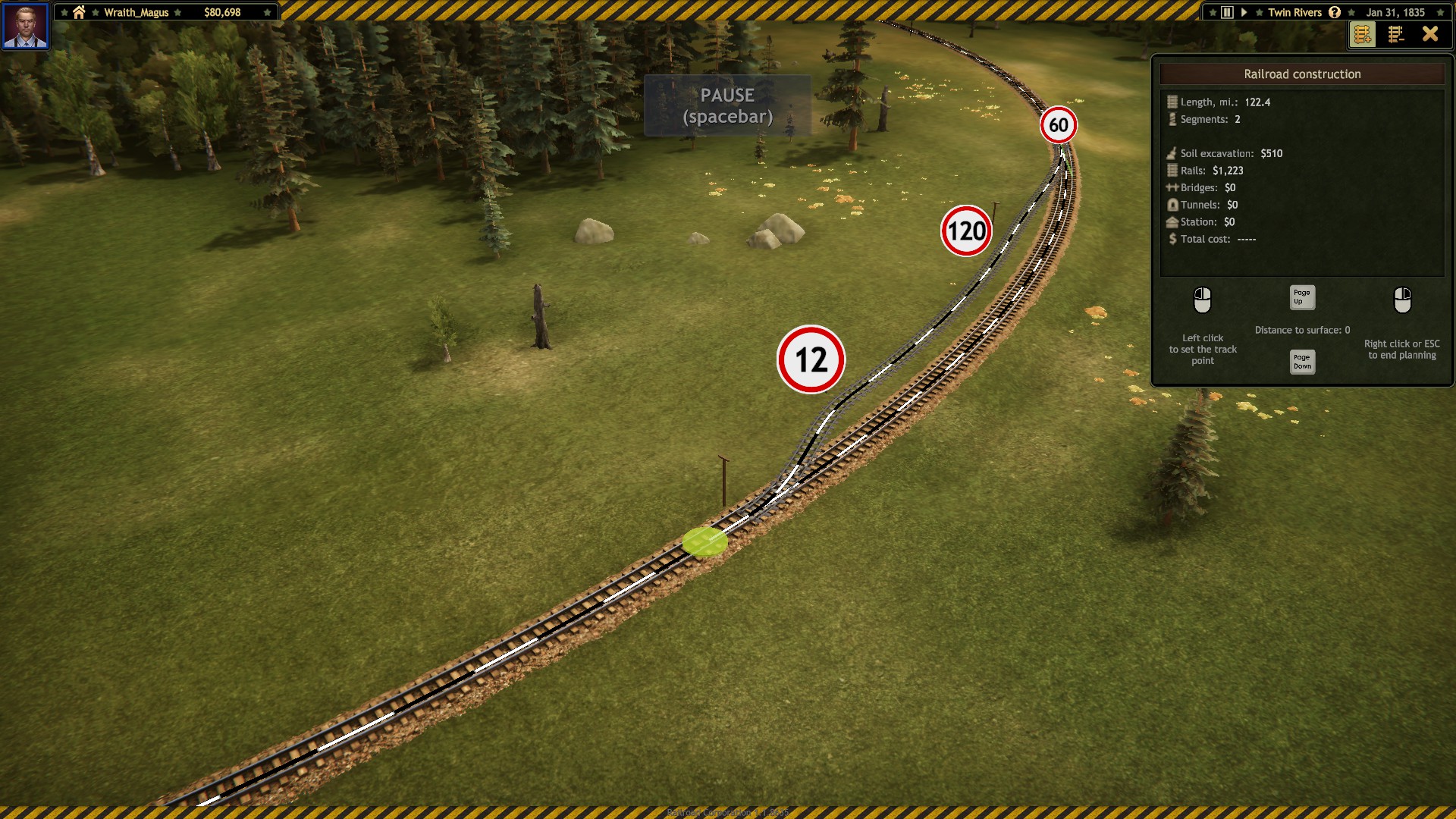
Gradual curves like that basically block off all of the track near that juncture from being used in any other junctures. In the picture above, I’m blocked from merging tracks gradually like above because I had clicked to set an anchor point/created a juncture in the segments of rail, and even an edge of a piece that is going straight blocks the ability to add merging or splitting of the tracks because of the stupid system used to define this free-form 3d track-laying system.
I need to talk about junctures and segments in detail, here. Basically, every time you click to set the anchor point of a curve, it creates a juncture point where you clicked (or where the game decided to snap regardless of where you clicked), and the curve tool creates a segment of rails between the junctures. In most games, this would just be some under-the-hood technical stuff that doesn’t impact gameplay, but in Railroad Corporation, the location of juncture points and segments have dire consequences for your traffic. See, juncture points, once created, never get smoothed over or reallocated unless you delete all the segments connecting to it. When you try to add in a new split or merge of tracks, it creates new juncture points, too, and even if those split or merge segments are later deleted, the juncture points remain. This is crucial because juncture points block the ability to create new juncture points or merging or splitting tracks. It’s also crucial because, in the absence of having track signals you can place yourself, juncture points basically are the signals that tell trains something is all clear – you want to have long stretches of clear segment because that’s fast track that gives plenty of room to create merges or splits later on, but if two trains are going in the same direction down the same rail, the second train will stop until the first train clears the segment in front of it, which means the game actively punishes having large segments of smooth track to go faster by making your trains slower. I cannot stress enough how infuriatingly backwards this whole system is. But don’t worry, you can always just delete large stretches of track every time you want to change the juncture points – it just costs tens of thousands of dollars and is your greatest expense besides buying the goods you are selling at market. So choose – do you put up with badly mangled tracks created by awful snapping the first time that slow down your trains and kill profits, or spend all your money and hours of your real life trying to fix them getting around the awful, awful interface for laying down tracks?
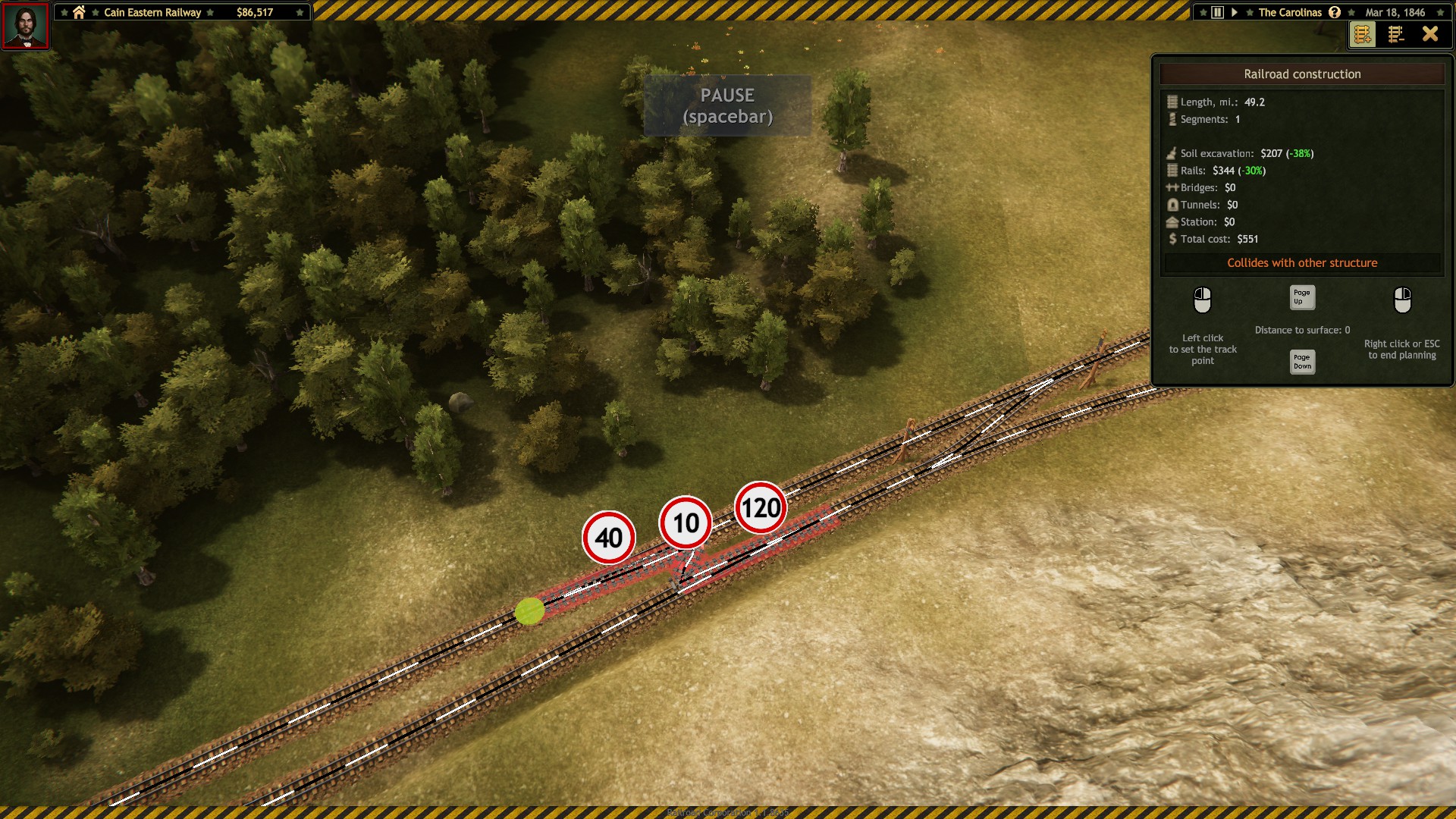
The above perfectly demonstrates the problem with how insane the snapping system is – I’m trying to make a switch over for a pair of tracks, and the game interprets this as “make the track zig-zag backwards for no reason!” It then complains saying “Hey, player, that zig-zag idea of yours is really stupid, because trains can’t do that.”
Another thing of note is that changes in elevation are nearly invisible. To save money, you basically have to pixel-hunt blind for places on the map that have less variation in the elevation so that you spend less on moving soil around. (Also, rocks cost lots of money to remove. Also, maybe forests? Sometimes it really reduces costs to go around dense forests, or at least aim for a narrower part of forest, but other times forests seem to have no more soil costs than open fields. Like everything else about this, I have no idea what this game wants from me.) It can seriously be the difference between a piece of track costing $30,000 if you just lay a track down without setting out junctures and if you carefully lay one out… but you can’t even see the obstacles, so there’s nothing you can do but blind guess-and-check. This is a leading cause of that “I spend 20% of the game just blindly groping around in rail-laying mode and pixel hunting to avoid snapping into things” because I have to test multiple potential tracks until I just so bored and frustrated I settle for bad placement.
Seriously, why do developers think that strategy or management games like this need to be 3d when they so obviously work better in 2d on a grid?
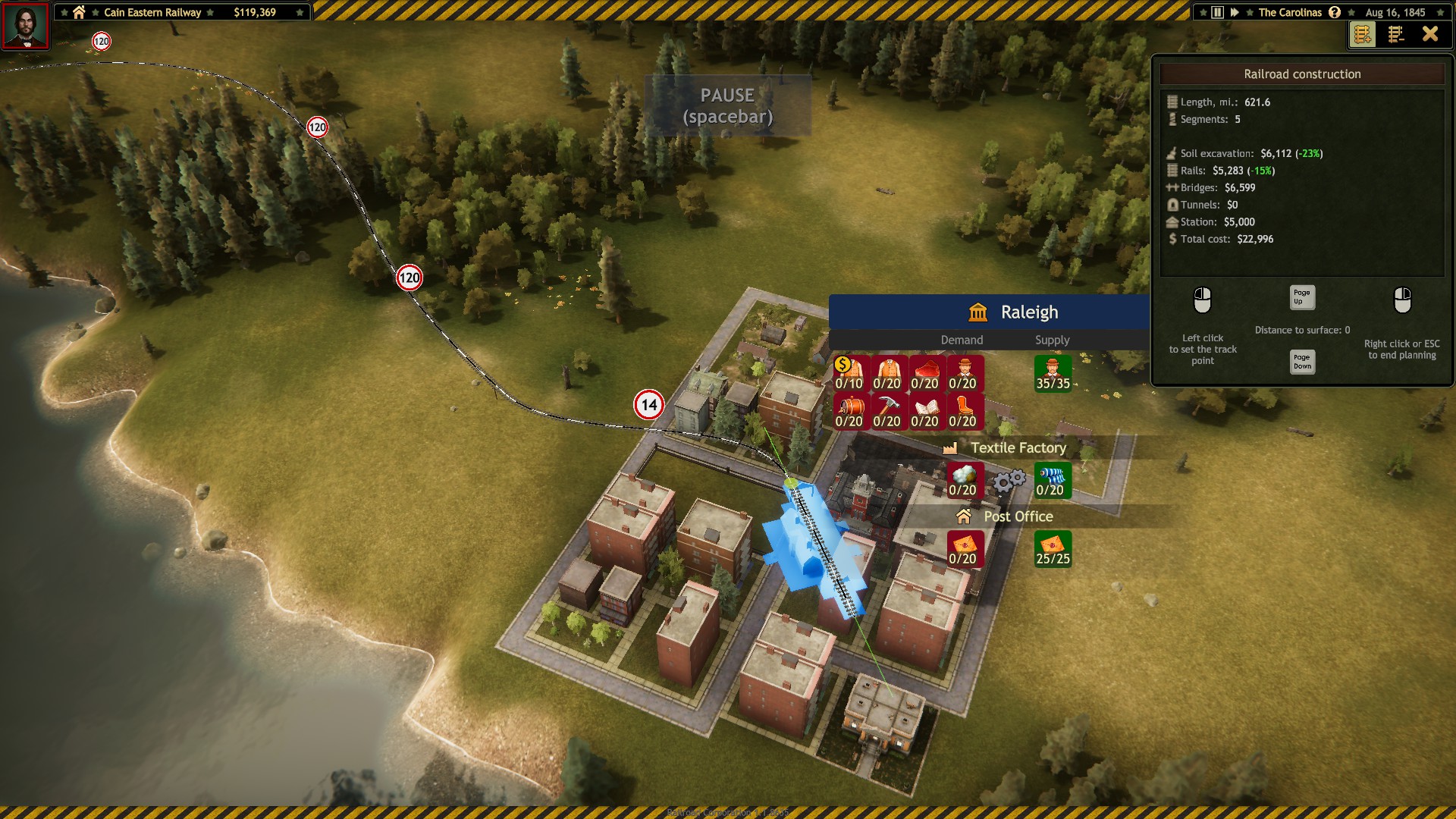
Snapping is even worse when it comes to the insane physics-defying railway stations.
When you first build a rail to a new town, a station’s ghost will be in the middle of that town, and it will reorient freely until you connect a rail to it. The station ghost, however, has an absolutely massive gravitational pull for snaps, easily larger than the town around it. Once you snap into that station, it’s also extremely difficult to escape the gravitational pull of that station, as well, without right-clicking to cancel and back out of building the track if you were anywhere nearby.
As the image above shows, there is absolutely no logic to the angle that the station will snap onto, so you have to yank back and forth with the mouse furiously to break free of the overzealous snapping mechanic and get a chance to blindly flail at the station in the hopes that next time it will snap into an orientation you could use.
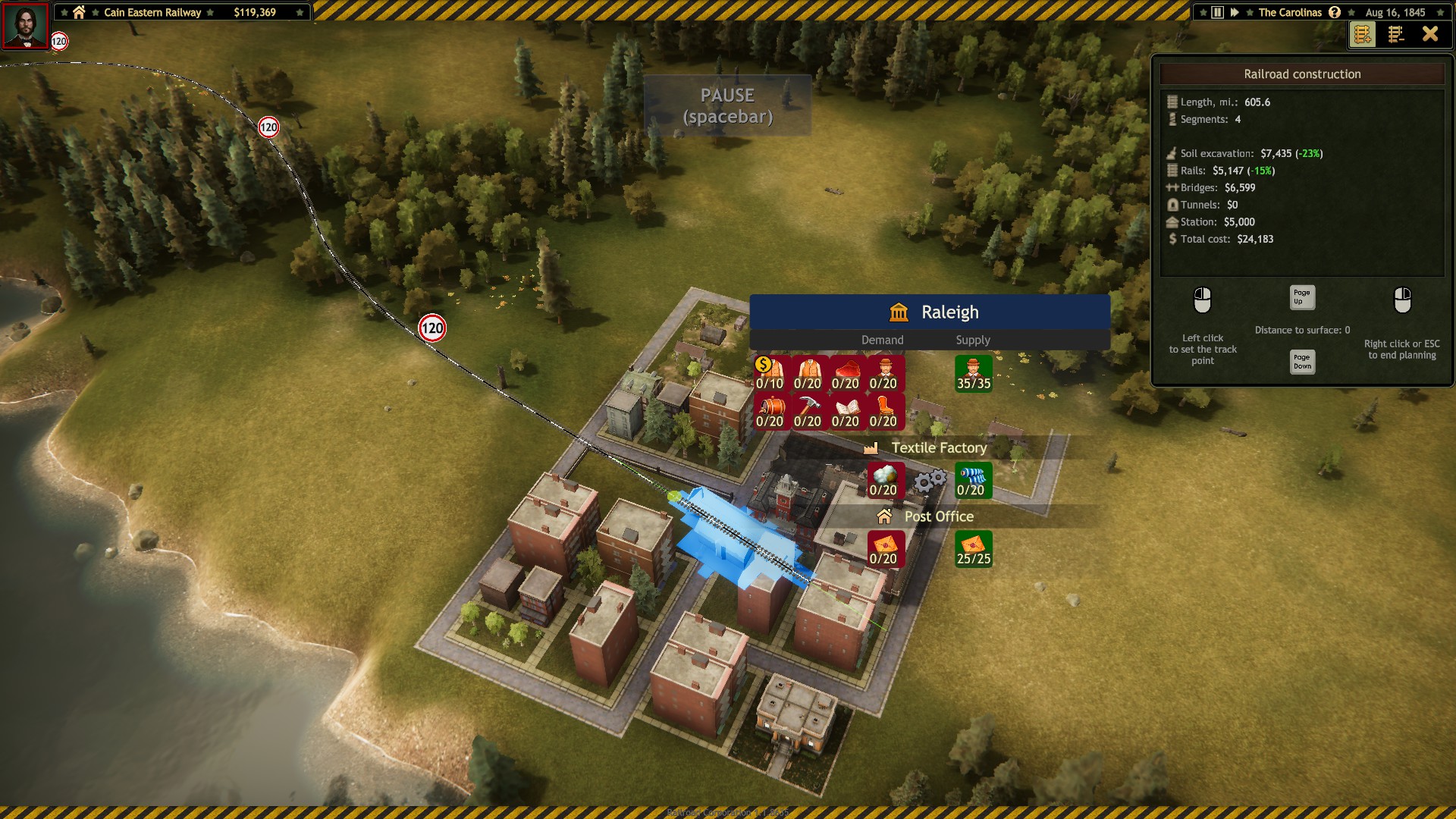
Why isn’t there just a button that lets you rotate a station, and therefore the angle the rails approach that station? For that matter, why couldn’t there be a button to turn on or off that snap to merge or to make merging or splitting lines gradual instead of sharp? Oh, right, because Corbie Games has a pathological hatred of a complete, functional interface with keyboard controls to make the game controllable, and want you to submit to the insane whims of the schizophrenic AI, instead…
I seriously, seriously hope that this snapping system was just some victim of a game having to be shipped at a given time regardless of the state of the game, and they’re going to actually patch and refine this, because I refuse to believe anyone thought this was a finished system that accurately interprets what players want.
Again, this just makes me long for the simplicity of 2d maps and grids where you can see what you are doing, and costs make sense, and you can control what you are doing. It helps make these supposedly Strategy Management games allow players to develop strategies when they can see and understand what they are facing, and then manage things because they are in control, not some stupid snapping AI that decides you wanted to build your rails as inefficiently as possible for no reason.
Stupid, Stupid, STUPID AI
Many of these sorts of manager games have stupid AI for the individual minions, but most of them give you some chance to fix or control the behavior in some way.
You can build two tracks to create two lanes of traffic. In Open Transport Tycoon Deluxe, I could set up signal switches to make tracks one-way so that trains only used the right-hand tracks in order to prevent the vast majority of problems. Open Transport Tycoon Deluxe could admittedly be a little intimidating figuring out those track signal switches at first, but understanding basic street traffic logic and how to set up stoplights works perfectly well. Railroad Corporation either didn’t have time to implement signal switches or they think that players are too stupid and to keep things more casual-friendly, just created an AI that will decide where to go for you. So just sit right there as uncle AI makes all the choices you can’t be trusted to make for yourself… like making all trains default to using the southern of a pair of parallel lines no matter which direction they are going, and either coming to a screeching halt when two trains nearly collide or just clipping through one another like physics is optional. (See the bugs section below.)
They also like to switch tracks even when the awful snapping track-laying feature forces you to set crossovers between parallel lines to very slow max speeds like 12 mph. If you set up several of these to try to counter the tendency for trains to go into head-on staring matches with each other, they’ll even zig-zag between lines for no reason just to slow themselves down!
Trains will also stop at a switch they are right in front of because there’s a train 300 miles away already on that track to wait for the train to come by (two game days later) even though there was nothing in front of them and they were clearly well in front of the other train. What makes one train decide it has right of way or not is apparently determined completely at random in this game, and has no relation to rational reality. Your trains will constantly stop for no apparent reason whatsoever, especially when you are tight on budget and you really need a train to make a delivery with expensive goods soon.
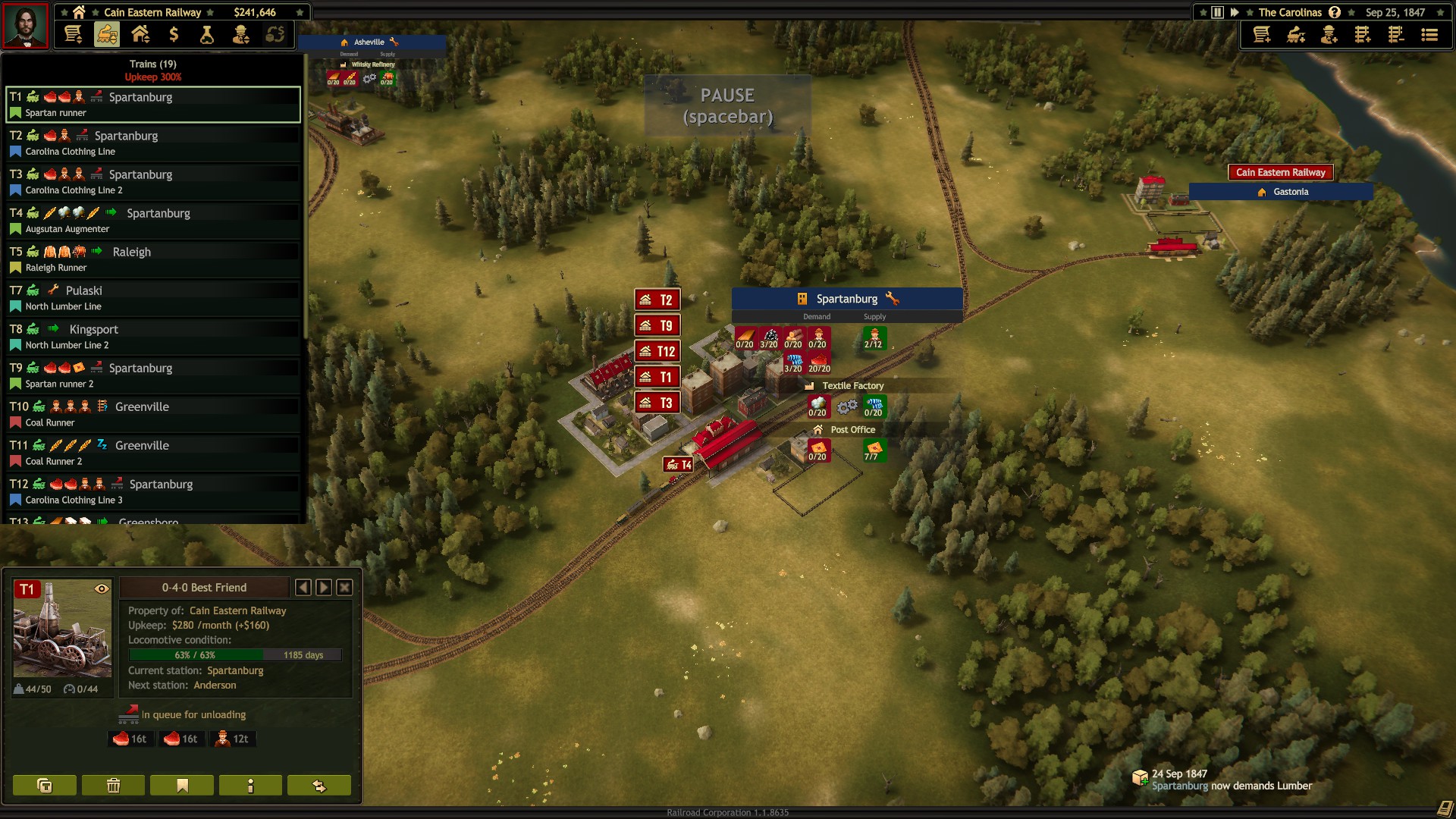
It’s also a major problem (although more an interface problem than strictly an AI problem) that the AI defaults to waiting for a factory to build something it may not have the resources to build or else waiting for cities to consume products when they are full on goods before they can be sent onto the next station. You can easily set trains not to wait to buy goods, although it’s severely annoying you have to, but you basically can’t leave trains without the ability to unload goods or they are overloaded and can’t function properly – remember, even if they don’t buy all their goods, weight slows trains down and snarls traffic, anyway. Clothing factories take two cloth and one leather to make one clothing, so I make sure to set all my trains feeding cloth and leather to the factory to have that exact proportion, and having extra cargo running around blocking the cargo I need to carry is a massive problem.
What does the game do to warn you when there is a problem like this? Basically nothing. It gives you no notice when there are trains carrying cargo it can’t unload taking up all its cargo space while running between stations eating up fuel not buying or selling anything. If a train (or 5) is stuck at a station like in the above picture for over thirty days it will deign give you a notice, but by then, if you didn’t do that on purpose to avoid finishing a mission so you could do more research, your company is probably doomed from the snarled traffic, anyway.
Basically, whoever the conductors of these trains are supposed to be, they cannot be trusted to breathe without your constant supervision, and giving them options to try to alleviate some of the basic stupid problems like heading into oncoming traffic only winds up confusing them and making them perform even more advanced and spectacularly stupid decisions.
The bad AI and the lack of any manual direct control over trains outside of stations is the number one cause of this game’s crippling bugs.
Hurry Up and Wait
One other thing I should point out is that, unlike many other games that let you keep playing past a victory screen, the mission is immediately over the instant you complete your final primary objective, even if you have secondary objectives yet to complete or are nearly finished on a research that will be wasted if it isn’t complete. Since completing secondary objectives gives you extra perk points for discounts, and at the end of missions, you tend to be flush with cash you’re in desperate need of at the start of a new mission, it makes the most sense to get up to the point where the train that will deliver the last load of goods necessary to complete a mission is parked one station away (you can’t stop a train on the rails), and just keep it there until you can finish all your secondary objectives and finish all the most expensive research you have access to until you’re just at the brink of the mission deadline.
There’s a bonus for completing missions under a set amount of time, but no bonus for completing it ahead of that time, so while that time limit is hypothetically meant to encourage you to be efficient with your time, it actually creates a major reason to dawdle in completing mission objectives so that you can be more efficient with your time in everything else. That’s not exactly great game design…
Music and Sound Effects
This is a game about trains set in America in the 19th century, so of course it has the sort of music that springs to mind when you think “tumbleweed and stagecoaches”. I’m honestly not sure if there’s only one track or if all the music sounds so similar that I just can’t tell the difference between one track and the other since I’m not paying all that much attention. After three missions, I broke down, silenced the music, and just started playing my own tunes. It’s not terrible music by any means, it’s deliberately inoffensive background period music. It’s just repetitive to the point of becoming monotonous after the tenth hour you’ve listened to the same tracks on played back to back.
So far as sound effects go, I often had myself zoomed out so far that I rarely heard them, but if you zoom in close, you can hear seagulls near the coast, the clamor of pedestrians near towns, and of course that nostalgic little “choo-choo” of trains leaving a station for all you train fanatics. This isn’t the sort of game where sound effects wow you, but they’re nice enough.
Bug Roundup
I get the distinct impression this is one of those games that left Early Access because the publisher said it was time to leave early access (likely because it was just before Transport Fever 2 was about to hit Steam), not because it was actually ready for prime time. I was actually offered a key before the game officially left Early Access, but because it was left in the queue, I actually only played it after the patch a month after leaving Early Access, and even with how long the list of bugs fixed in the patchlist were, I still routinely encountered bugs that were minor, major, and even game-breaking. It seems like at least once per mission (outside the tutorial first chapter), I managed to encounter a game-breaking bug that would make the mission incompletable without having to reload a save before the bug occurred.
But hey, let’s start small. Railroad Corporation has no collision detection. Trains follow where rails are placed, regardless of whether they collide with either obstacles or other trains.
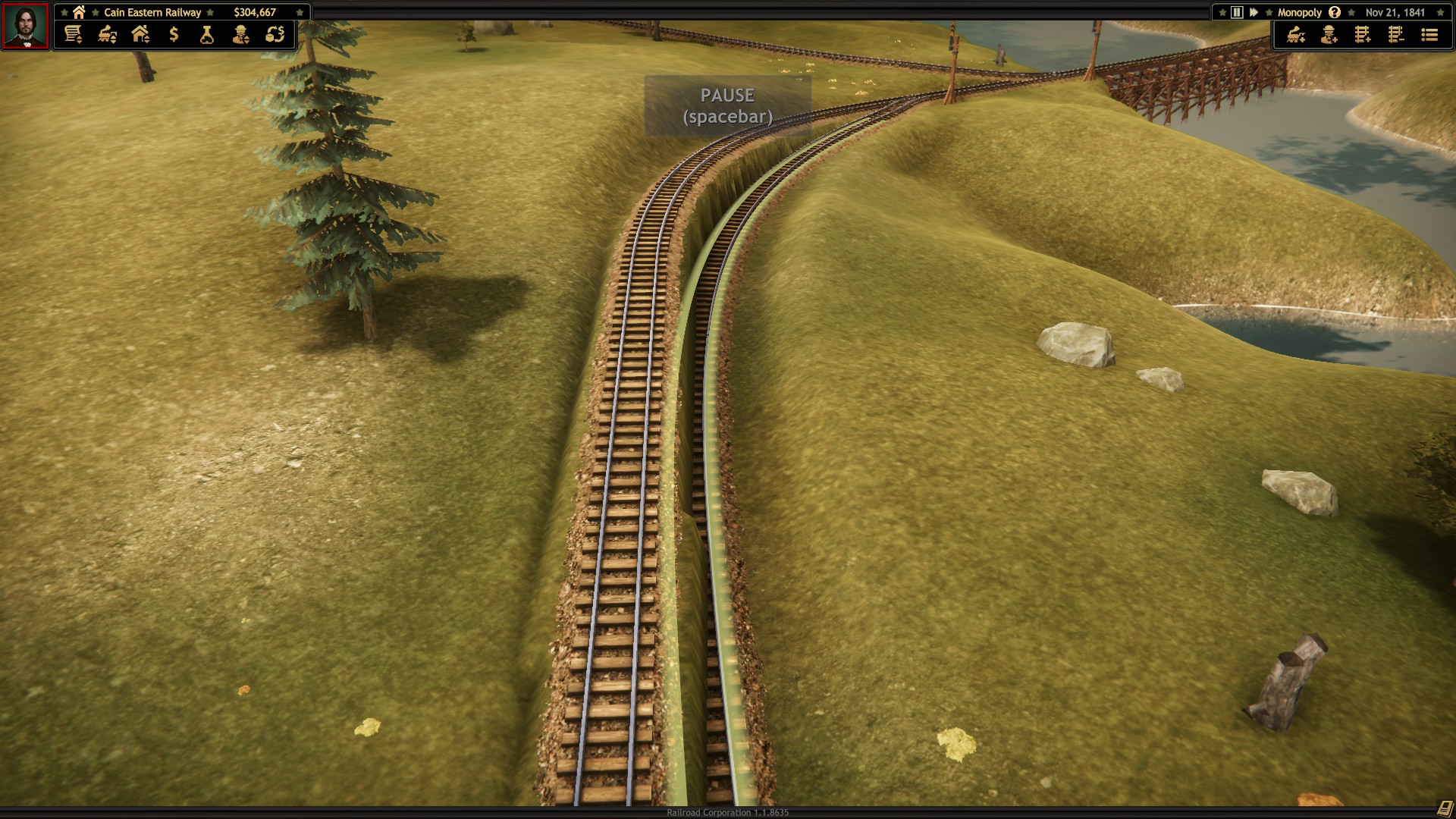
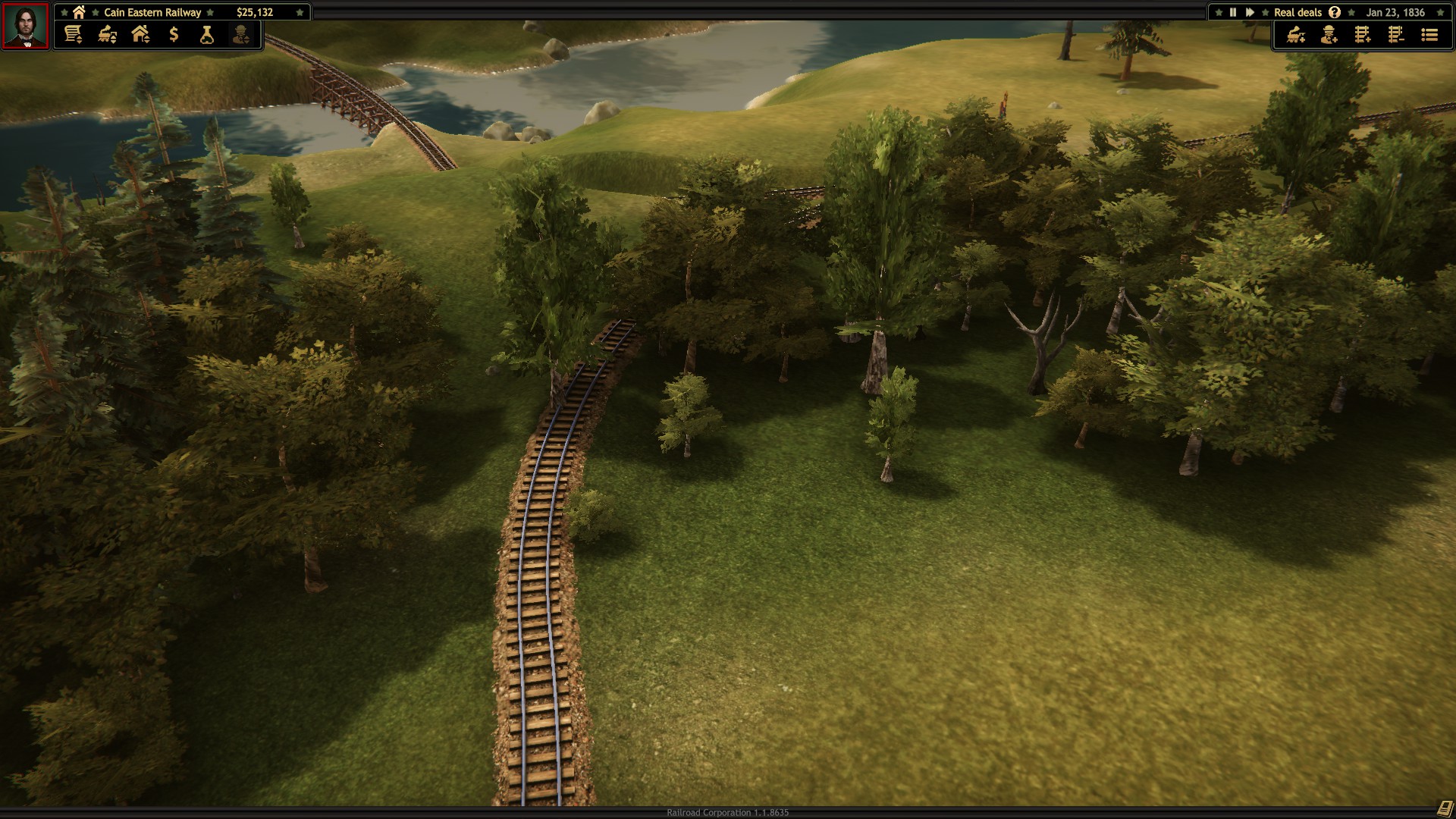
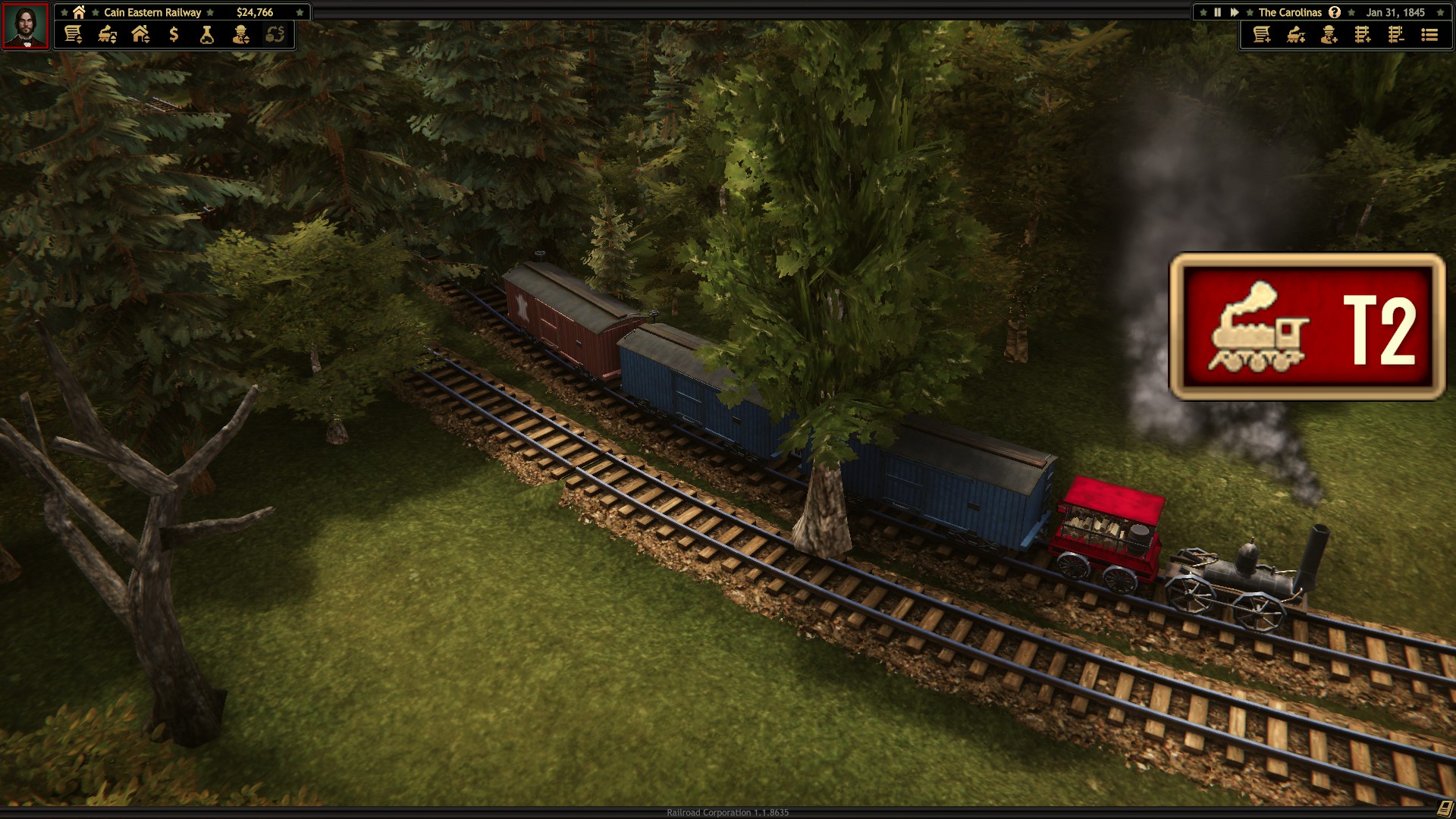
Sometimes trains that are waiting for the area in front of the station to be clear before they leave get confused or perhaps impatient, and just phase straight through the other trains without the slightest hint that there is an obstacle. They can do this at switches as well, deciding to plow through one another.
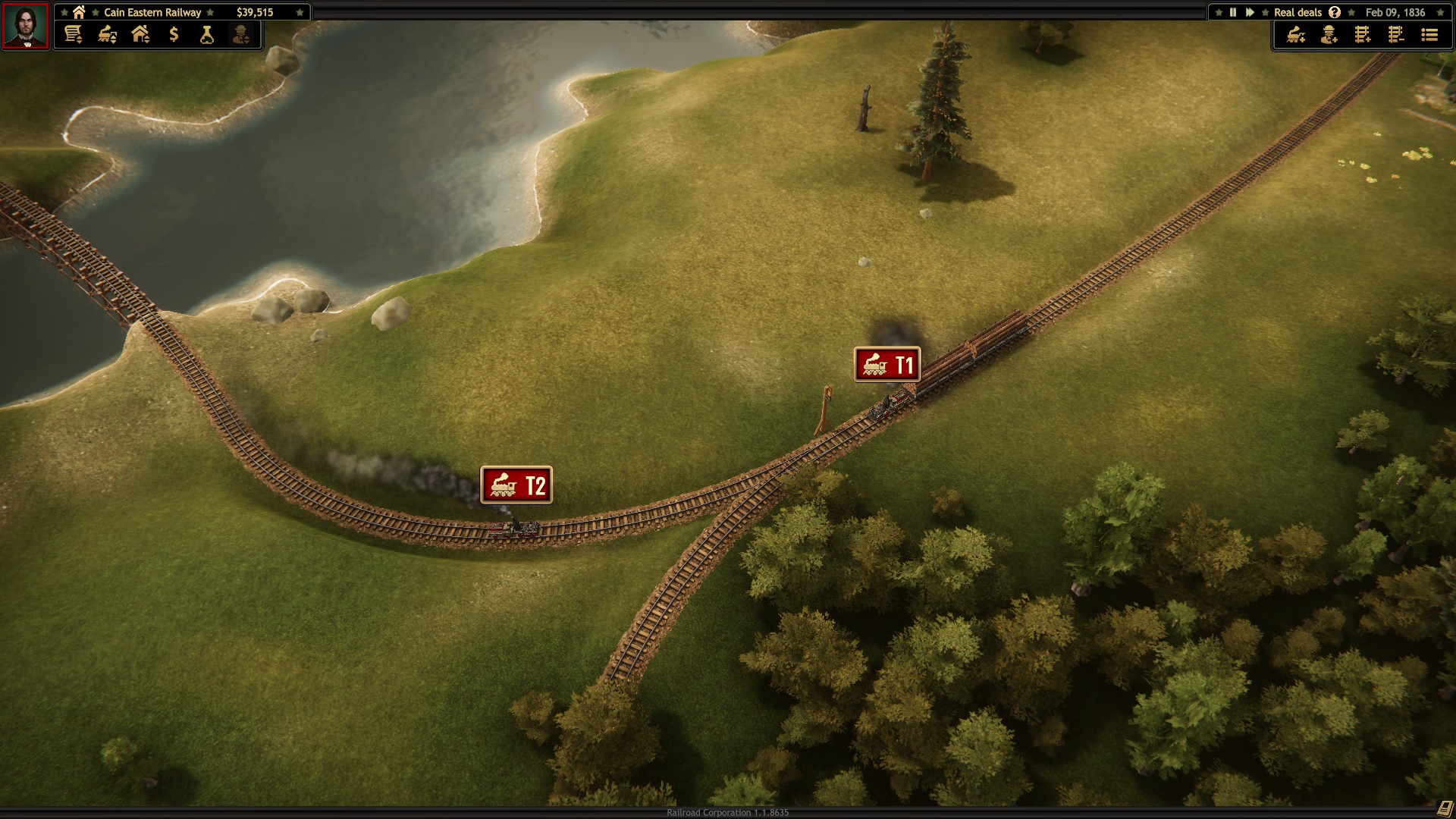
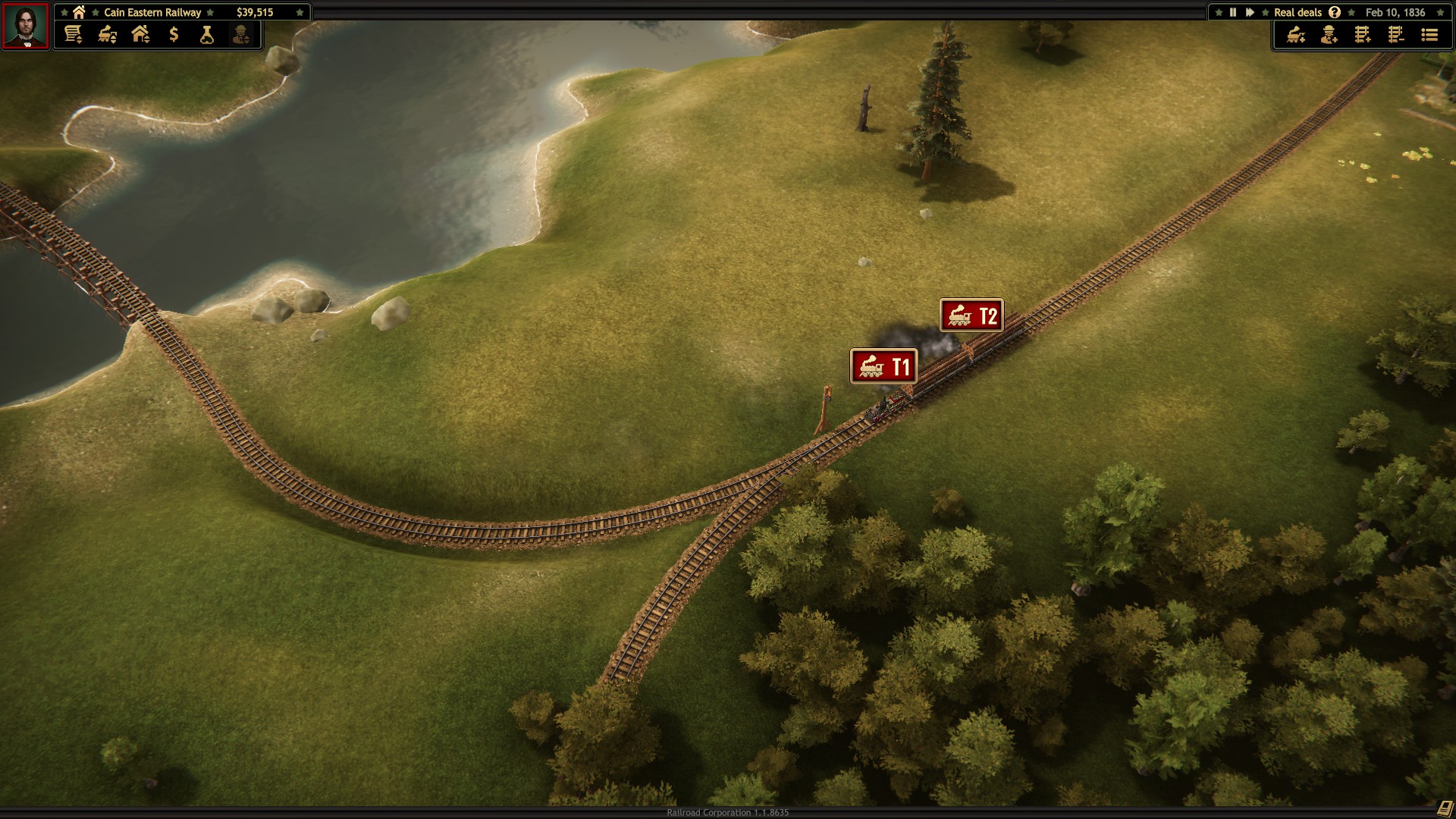
I don’t mind this, however. It’s funny and doesn’t cause any real problems. In fact, I wish they’d do it more, because a bug where trains fail to recognize obstacles and ethereal jaunt through them don’t introduce delays in my schedule. The same cannot be said for its game-breaking opposite: Trains that line up in front of a switch and stare each other down without ever moving.
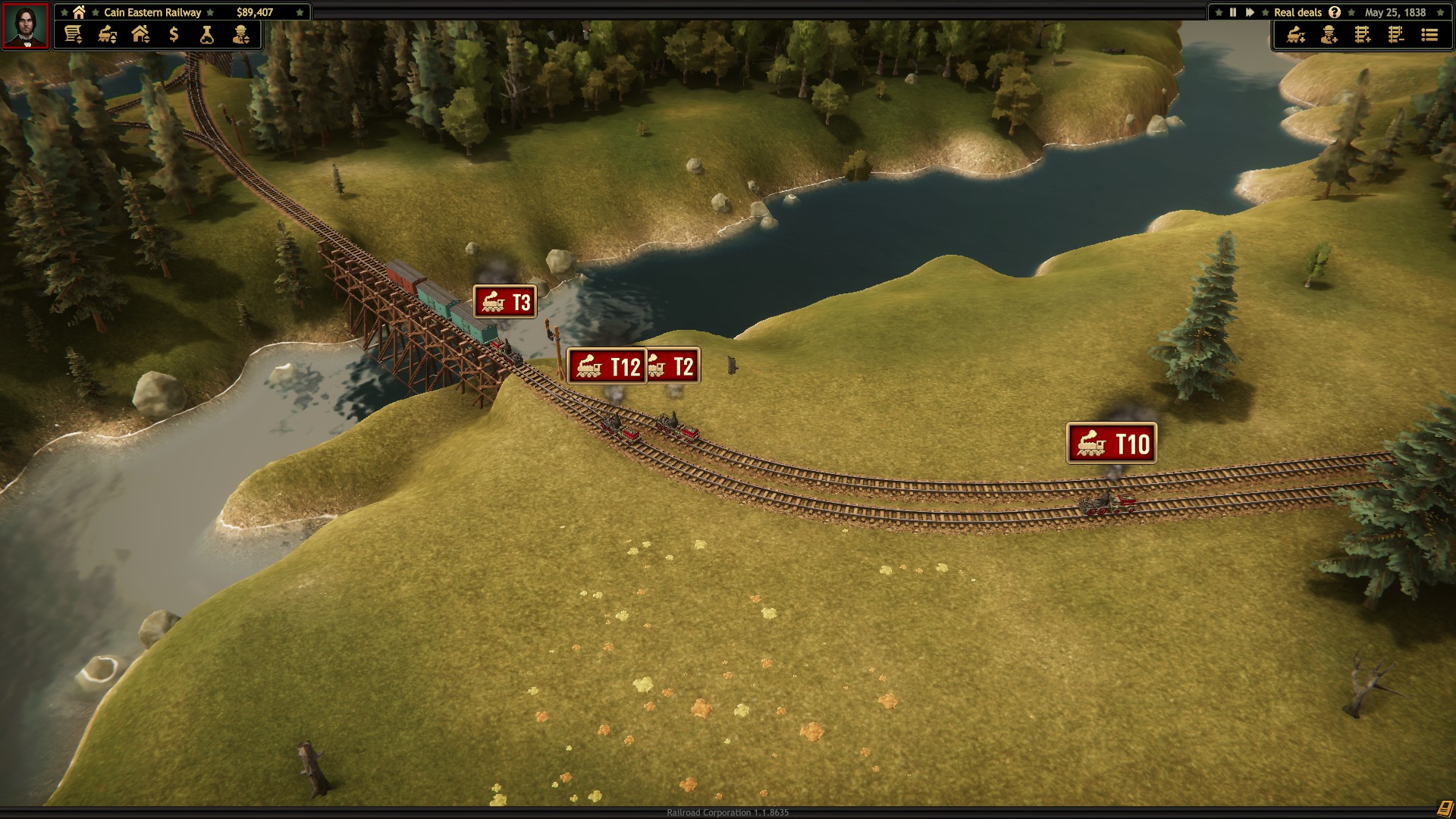
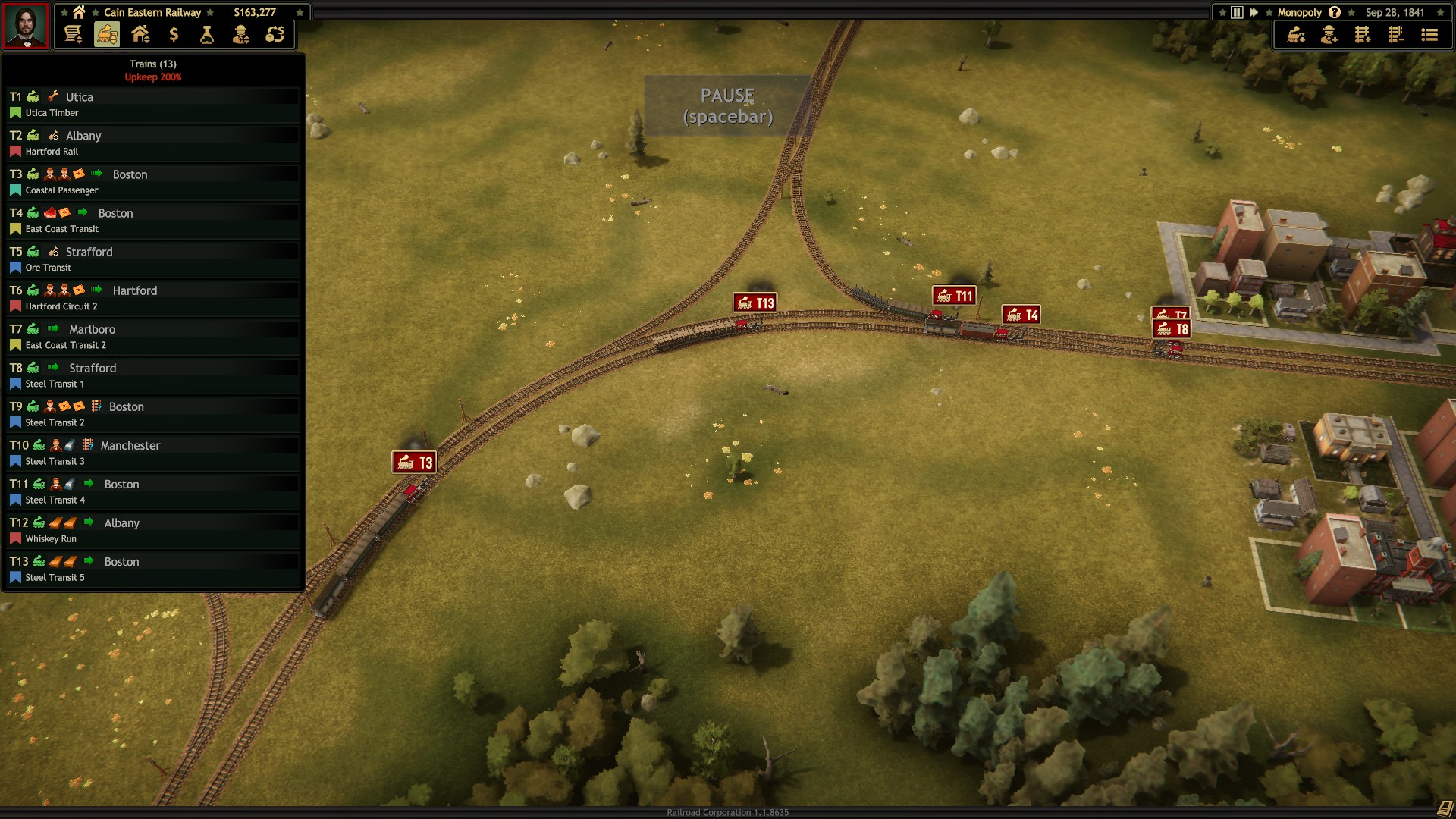
Once again, I should point out that most games have a feature that lets you order a train into reverse in situations like this, or have a “force start” where you can override bad AI telling a train not to go forward. (But those games also have collision detection so the train can derail if you’re wrong, while Railroad Corporation will probably get around to adding that feature… eventually.) You also can’t build new tracks to try to give trains another offramp because of the awful snapping “feature” while building tracks in this game means you can’t build a new track anywhere within 50 miles of a previous juncture of segments, you have to delete whole segments at a time, and you can’t delete segments anywhere near existing trains.
There are also bugs that cause a train to never leave a station because they’re constantly waiting on a track to be clear (even when there is nothing on the track), or waiting on cargo when they are full up even after I clear off loading all cargo. The train will never leave the station again.
Of course, it’s not just the AI that causes problems in this game.
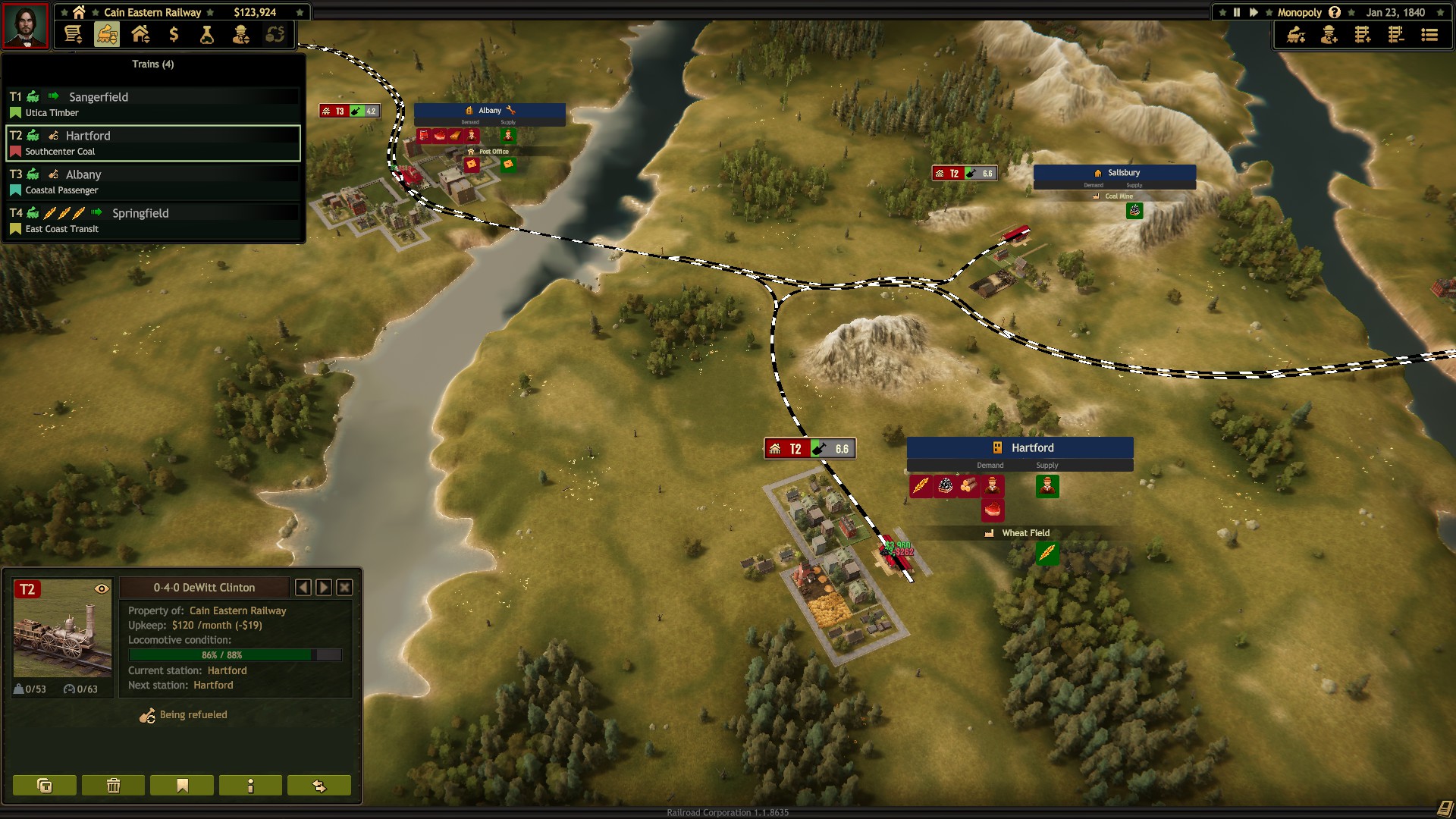
I frequently get bugs where train indicators remain in a station long after they leave that station. The indicators even match the status of the train in particular, indicating refueling when the train is actually being refueled.
Remember how I said that it’s anything from annoying to devastating if you don’t click “apply” to save changes to the train’s schedule? Well, there’s a bug that causes it so that when you click “apply”, the apply button goes away, but the schedule doesn’t change, anyway. Click the schedule closed then open it again, and it’s back to how it was before you made changes, even though you clicked save. It’s massively annoying at the very least to have a 5-minute change to a schedule disappear, but remember, you might need to make changes to avoid trains making supply purchases that can put you into debt or out of business, so this can be a game over if this bug strikes you unawares.
Also, it’s worth noting that contracts are problematic in that their rewards can be really wildly inappropriate. I’ve even seen contracts being offered that pay $0 for giving them goods worth about $40,000. A real steal of a contract if someone is willing to accept, am I right?
I’m also scared of the logbook button, which is inconspicuously hidden in the bottom-right of the UI with no label. If clicked, it’s supposed to cause a menu to appear that recounts the last few messages you’ve received, but for some reason, clicking it for the first time in a game causes the whole game to freeze for a minute or so like it’s loading up something extremely resource-intensive when it’s just text.
Verdict
So, how do I rate this fairly? Even if I were to be very charitable and put the game-breaking bugs aside, presuming that they’ll be fixed eventually and just suggest people buy it after a few more rounds of patches hit it, that still wouldn’t mean it in any way surpasses the games Railway Corporation was based upon. It’s 3d and maybe a little simpler to get into just because there are so many features lacking, but I honestly liked the old, janky 2d grid-based game better, and Open Transport Tycoon Deluxe brings a really competitive price to the table: Completely free and open source. That said, I’m comparing it to a classic I’d give the maximum rating to without reservation, so do I rate this game purely on its own merits and whether it can be fun, or do I rate it compared to the opportunity cost of playing a game I think does the same thing better?
In the end, I’d like to say is that because some of the more complex features like signal switches and other traffic control methods aren’t implemented this might be good training wheels for new players who won’t be nagged by the feeling it doesn’t quite live up to the classic it tries to modernize… but then, the absolute lack of any kind of manual or explanation in-game of most of the features would turn off anyone who actually needs the help!

